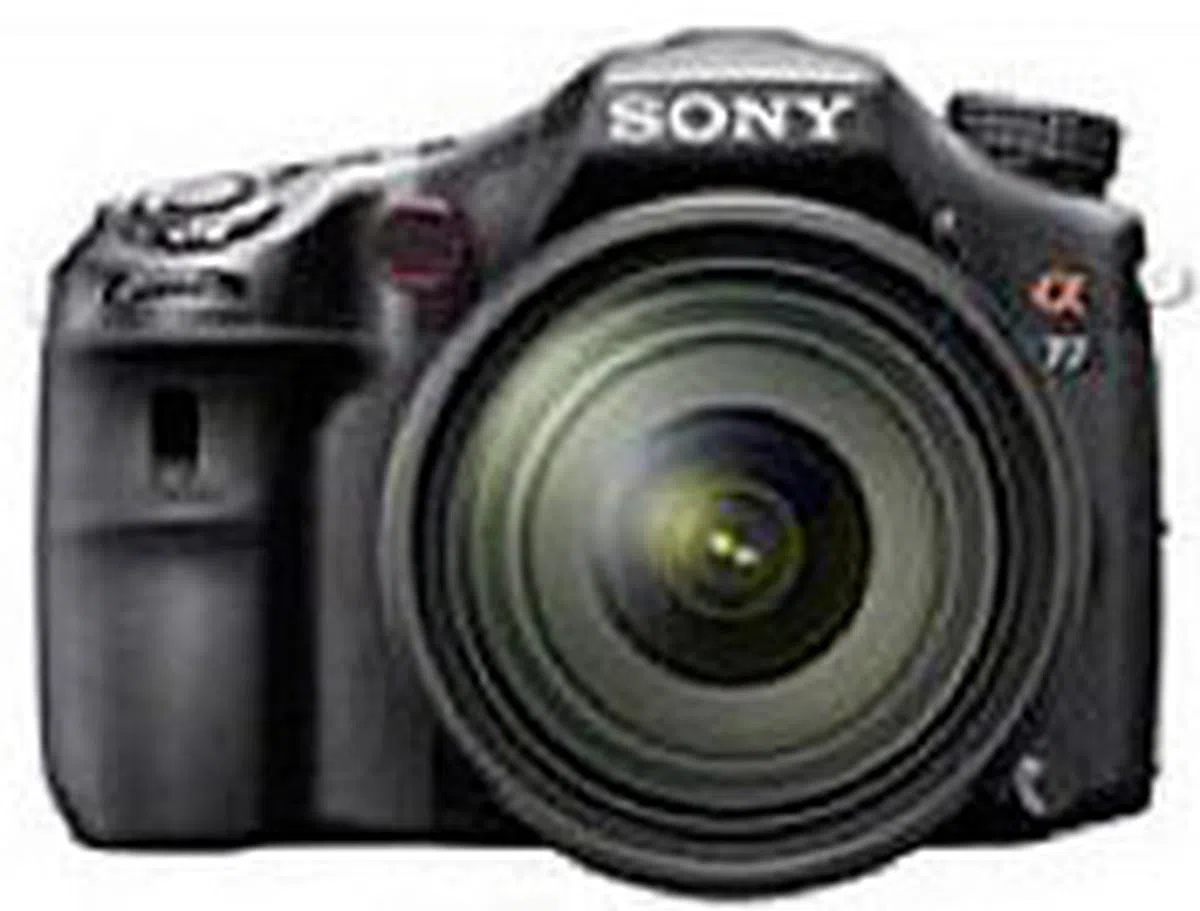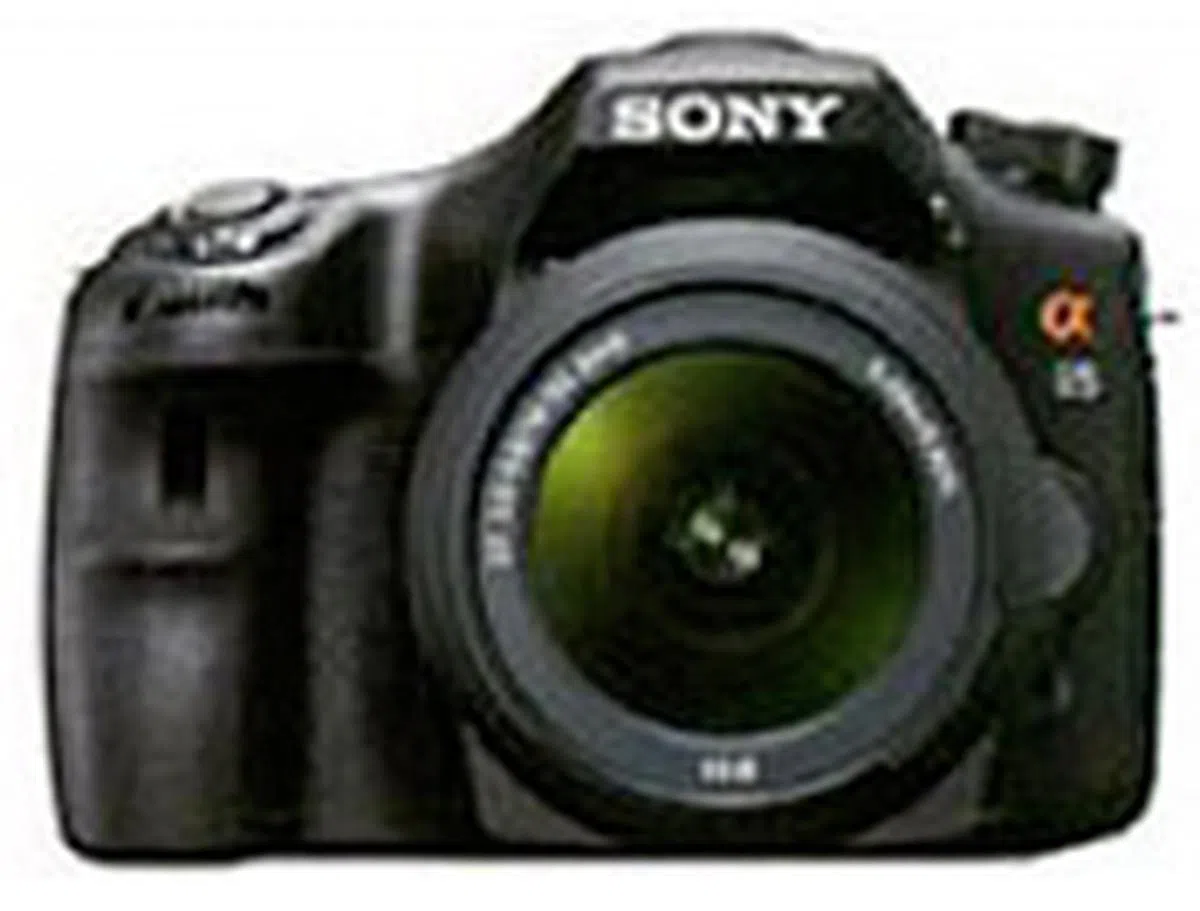Preview: Sony Alpha SLT-A77
After four years, the successor to Sony's Alpha A700 semi-pro DSLR has finally arrived. The SLT-A77 uses the company's translucent mirror design, has a top burst shooting speed of 12fps, and shoots full HD videos in 50p and 25p formats. But these are not all it's capable of. Come on in to find out more!
By HardwareZone Team -
The A700's Translucent Successor
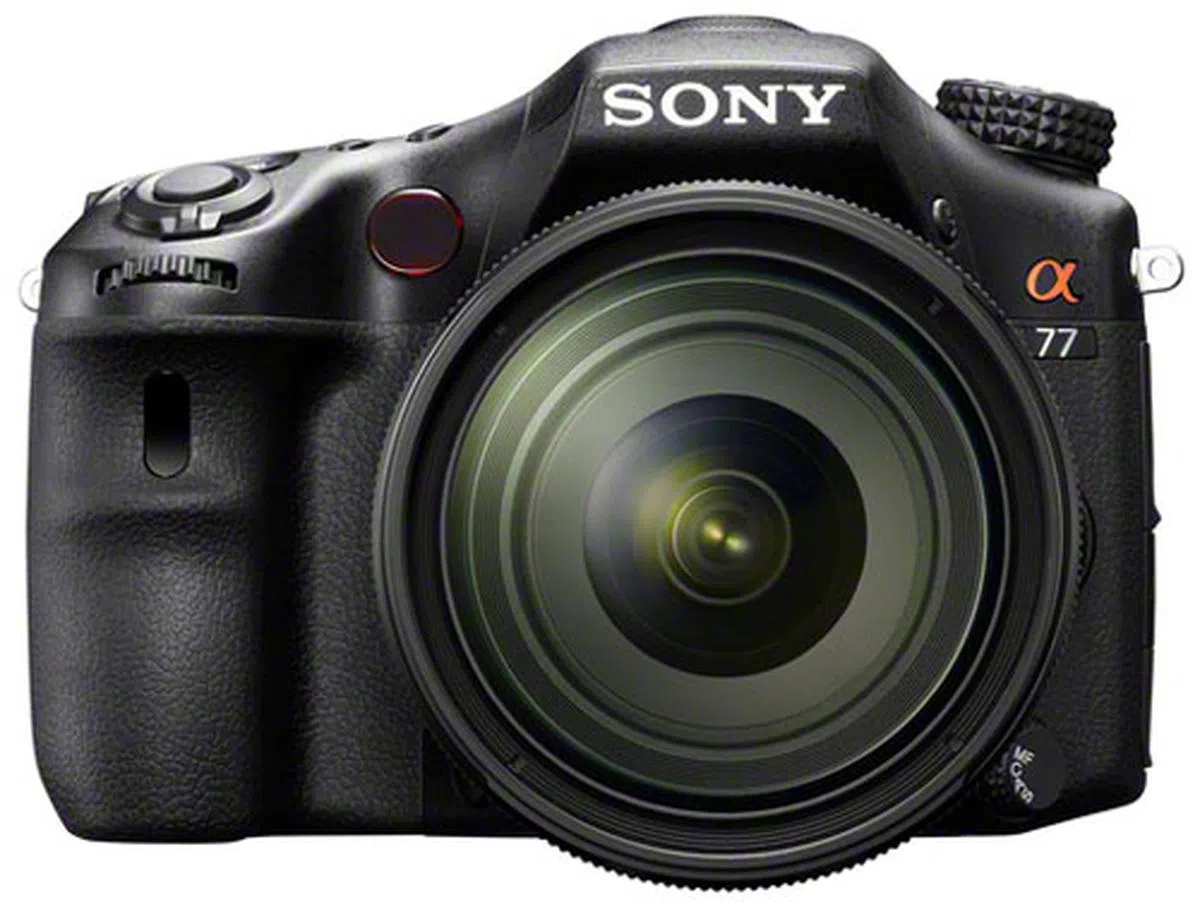 |
This preview is based on a pre-production model of the SLT-A77. |
Exactly a year ago, Sony unveiled the Alpha SLT-A55 and A33, a pair of interchangeable lens cameras that use the company’s translucent mirror design. Unlike a conventional SLR (single lens reflex) camera that uses a reflex mirror that flips out of the way during an exposure, the Sony SLT (single lens translucent) camera uses a mirror that’s fixed and translucent. Being semi-transparent, majority of the light coming through the lens will pass straight through it to the image sensor behind, but a small portion will also be directed to a phase difference detection auto-focus (AF) sensor module located at the top of the camera. This implementation results in several advantages; the key one being the ability to achieve full-time, continuous AF, even during video recording. It also enables the A55 to do burst shooting at up to 10fps (frames per second), a spec unheard of in an entry-class, sub-S$2,000 DSLR prior to this.
In June this year, Sony began refreshing its SLT lineup with the introduction of the SLT-A35. A slightly updated A33, it gains a redesigned version of the 16.2-megapixel CMOS sensor found in the A55, refinements in power consumption, longer video recording (29 minutes at a go), and an in-camera ‘Picture Effect’ setting. But it loses the tilt LCD and does a 1.4x crop when shooting at 7fps. An A55 successor was however ostensibly missing.
But if there’s a poll for the most eagerly awaited camera among the Sony Alpha and Konica Minolta faithful, the successor to the A700 would top it with ease. Launched in September 2007, the 12.2-megapixel A700 was the second DSLR (the A100 being the first) from Sony after its acquisition of Konica Minolta's camera business; and it went head-to-head with mid-range models from Canon and Nikon, such as the latter’s D300. A mockup of an A700 successor was finally shown in September last year at Photokina, and again in this year’s CES and CP+ trade shows. It's going to be an SLT camera, and the word at the time was that it’d arrive in the middle of 2011; but June only saw the A35 and the NEX-C3.
In any case, the SLT-A77 is finally official, along with the SLT-A65. True to rumors and leaks, both sport the same 24.3-megapixel APS HD CMOS sensor, which is Sony’s highest resolution APS-C size sensor yet. The A77’s maximum continuous shooting rate of 12fps is also the fastest ever in a Sony Alpha camera. Sony also boosts of a couple of world’s firsts: an XGA (1024 x 768) OLED (organic light emitting diode) electronic viewfinder (EVF) and a 3-way tilt/swivel LCD monitor (only on the A77). In the video department, both cameras have adopted the new AVCHD 2.0 (Progressive) format; that means 50p and 25p full HD video recording (60p and 24p if you’re in NTSC land) are now possible.
|
| |
Camera | SLT-A77 | SLT-A65 |
Sensor |
|
|
Continuous Shooting |
|
|
Continuous Shooting Buffer |
|
|
AF System |
|
|
ISO Sensitivity |
|
|
HD Video Recording |
|
|
Viewfinder |
|
|
LCD |
|
|
Shutter |
|
|
Popup Flash |
|
|
GPS | Yes | Yes |
Vertical Grip | Optional (VG-C77AM) | N/A |
Battery Life |
|
|
Body Material | Magnesium alloy and plastic | Plastic |
Dimensions | 142.6 x 104.0 x 80.9mm | 132.1 x 97.5 x 80.7mm |
Weight (body only) | 653g | 543g |
Versus the SLT-A65
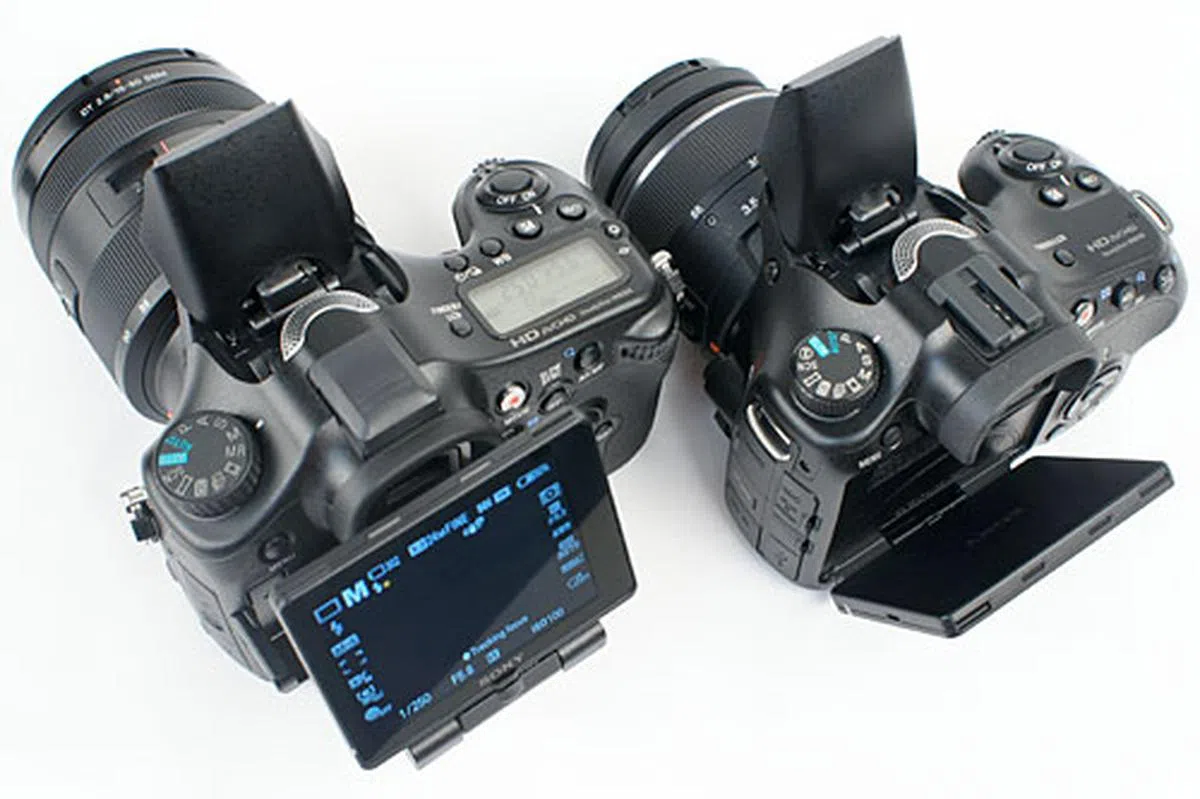 |
Both the A77 and A65 come in body only as well as kit versions. The A77 kit packs the new 16-50mm F2.8 SSM lens (24-75mm in 35mm equivalent); the A65 kit has the 18-55mm F3.5-5.6 SAM lens (27-82.5mm in 35mm equivalent). |
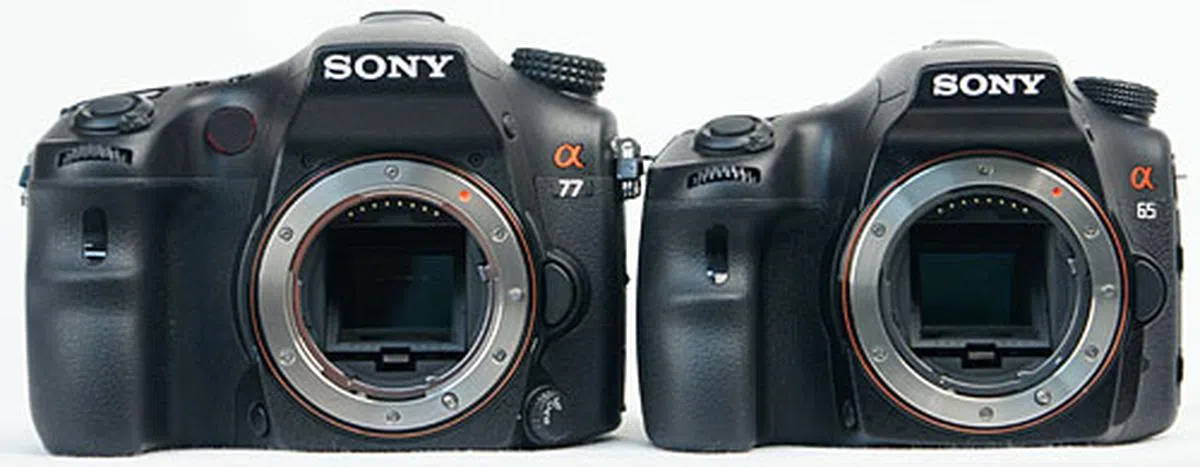 |
The A77 is noticeably larger than the A65, at about 1cm taller and 7mm wider. It's also 110g heavier. |
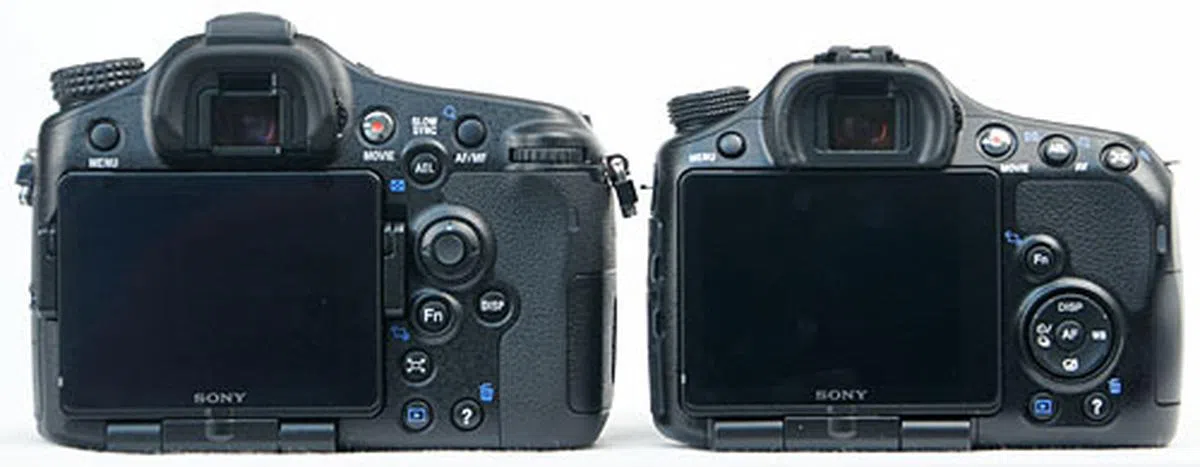 |
The back of the A65 (right) resembles closer to the A35/A55, than to the A77. The rash of buttons on the A77 reminds us of the A900 and A700. So, while the A65 uses the same 24-megapixel sensor as the A77, it's not in the same class as the latter. Rather, the A65 is more like a souped-up A55. |
3-way Tilt/Swivel LCD
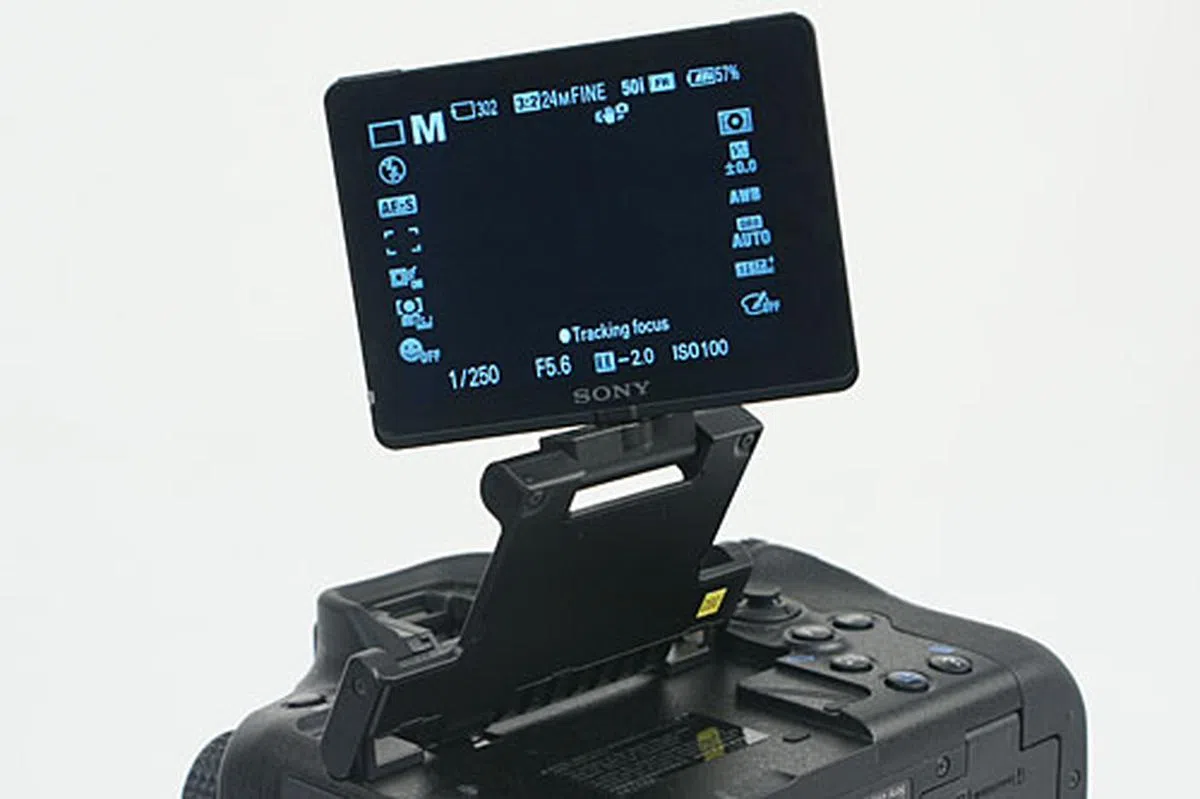 |
The A77 has a 3.0-inch, 921,600-dot LCD monitor. Sony is clearly trying to improve on the flexibility of the flip-down, tilt/swivel LCD found on the A65/55/33. While the latter is fully articulated, because it tilts downward, it's impossible to see the screen from the front when the camera is placed on a table or a tripod. Sony solves the problem by incorporating another plate to tilt the LCD upward. We've got to say, that's pretty clever. |
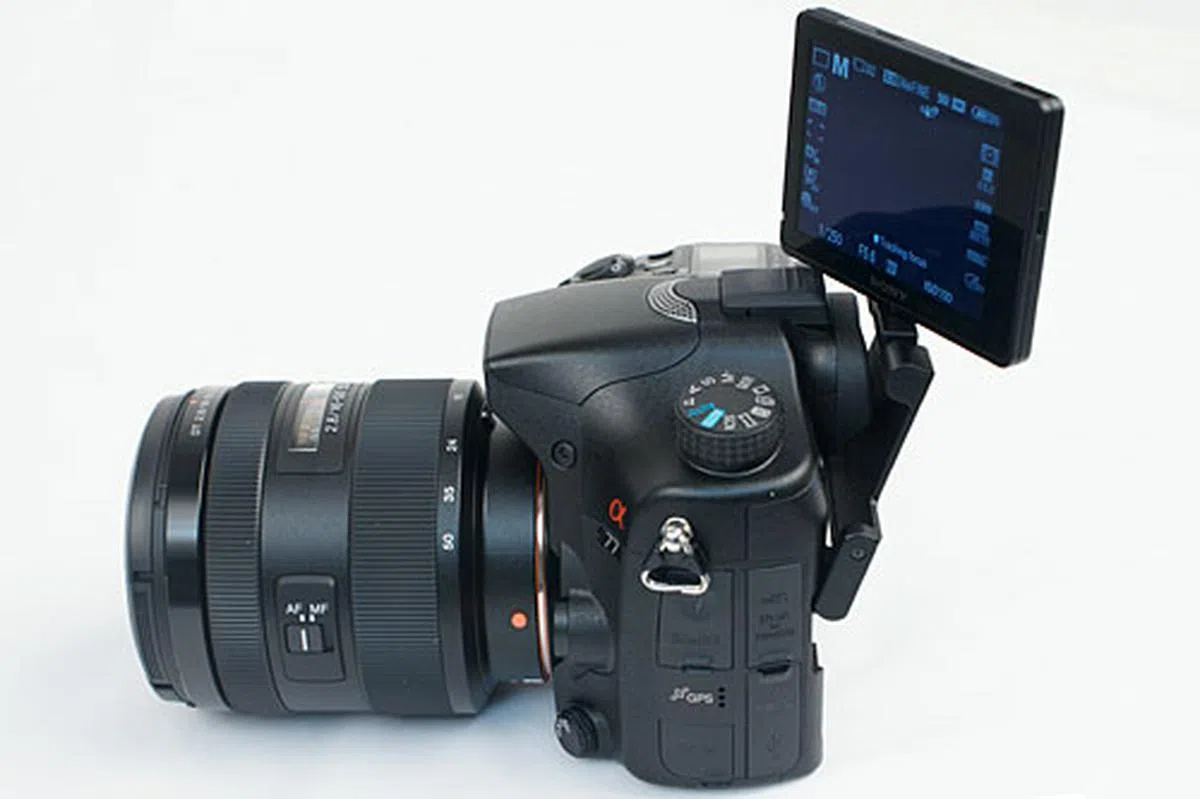 |
With the new mechanism, the LCD can be tilted upward by 150 degrees. You can now mount the camera on a tripod and still do a self portrait. The swivel angle remains at 270 degrees. |
XGA OLED Electronic Viewfinder
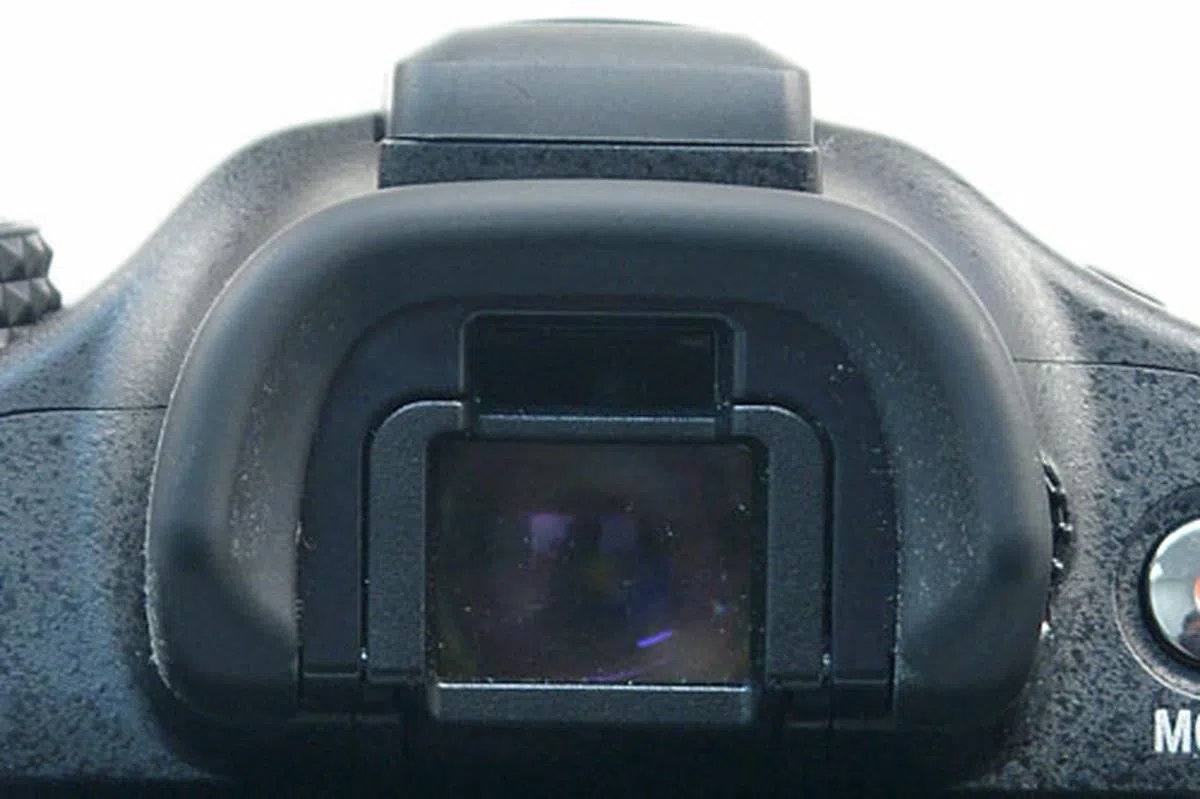 | Both the A77 and A65 have a XGA, 2.36-million-dot OLED EVF. Sony claims that it has 10 times higher contrast than conventional EVFs. It has a diopter adjustment dial and an eyepiece sensor that controls the EVF/LCD switch and Eye-Start AF. It also has a high eye-point of 27mm. The finder image is gorgeous: it's big, bright and very high-res. The color tearing issue that's plagued the A55/35/33 isn't present here. |
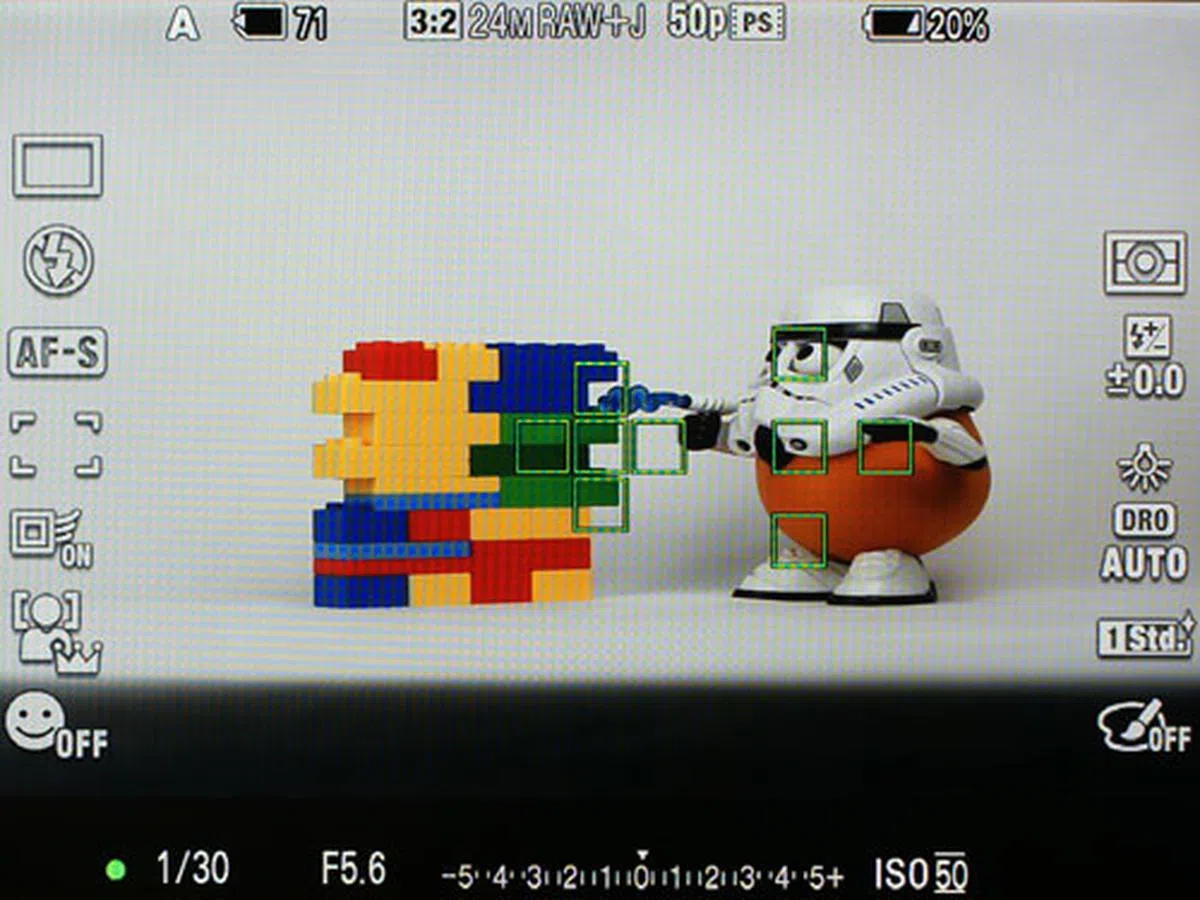 | A key advantage an EVF display has over an OVF one is the latter's ability to display vast amounts of shooting information (as much as the rear LCD monitor), making it possible to adjust settings without taking the eye off the viewfinder. For example, effects (such as changes in exposure and white balance) can be previewed in real time, and focus can be checked and fine-tuned by enlarging a portion of the image. |
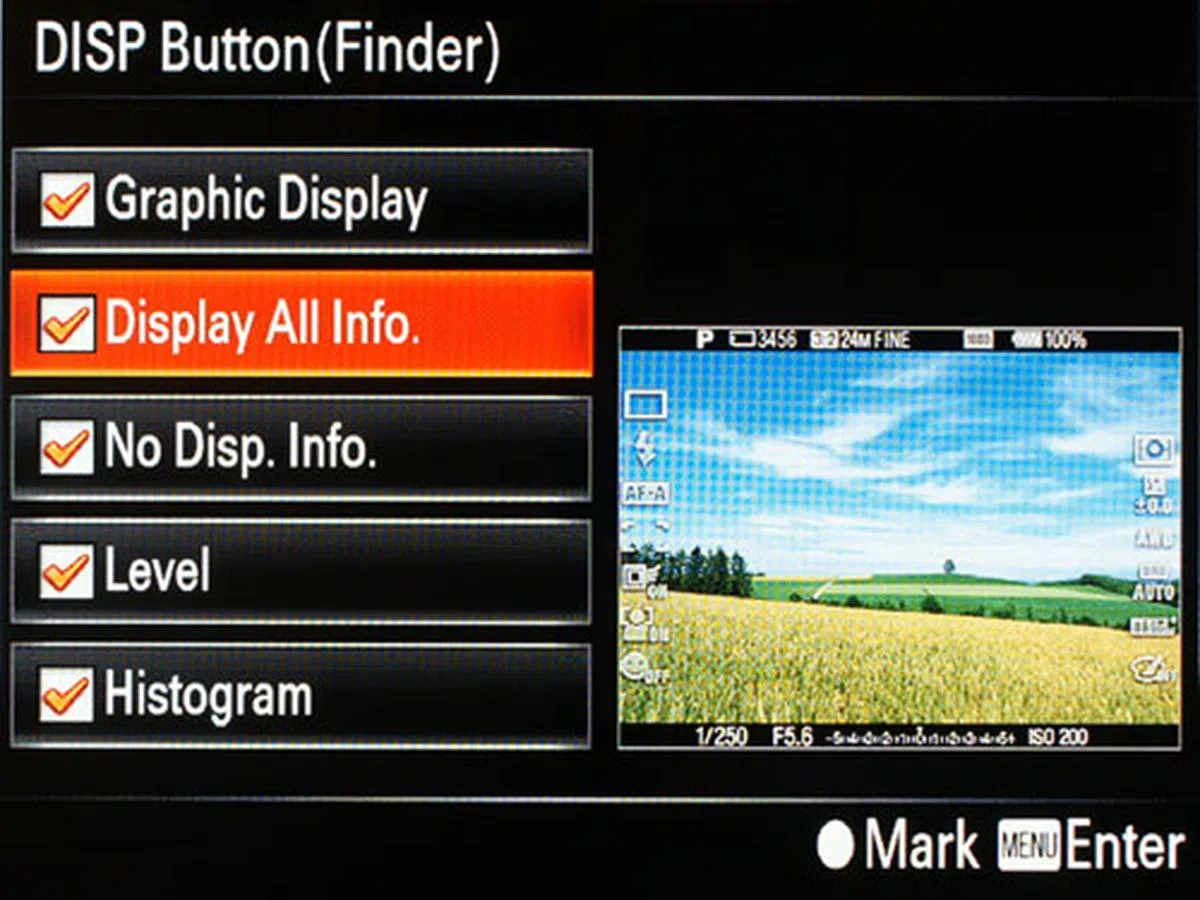 | You can decide the amount and type of information you want to see overlaying the image in the finder (a similar setting is available for the LCD). For example, you can choose Display All Info. to show all the shooting parameters, Level to show the axis level gauge, or Histogram to show a histogram at the bottom right corner of the frame. |
Full HD Progressive Formats Video Recording
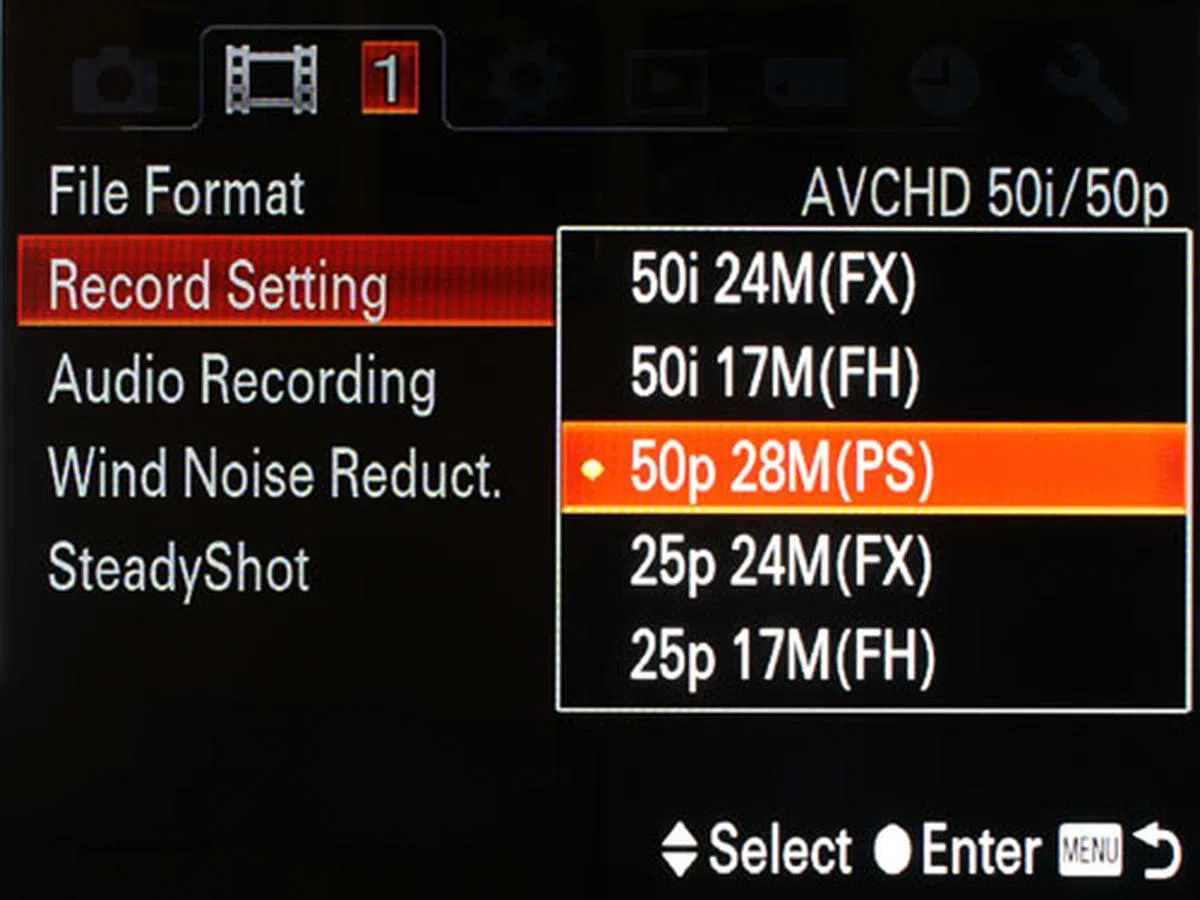 | You can now record HD videos at 1920 x 1080/50p (60p for the NTSC model) with a maximum bit-rate of 28Mbps. As with previous video recording-capable Alpha cameras, there are no convoluted steps to engage video recording mode; a dedicated red Movie button is located prominently to the right of the EVF. Press it to start recording, and again to stop. |
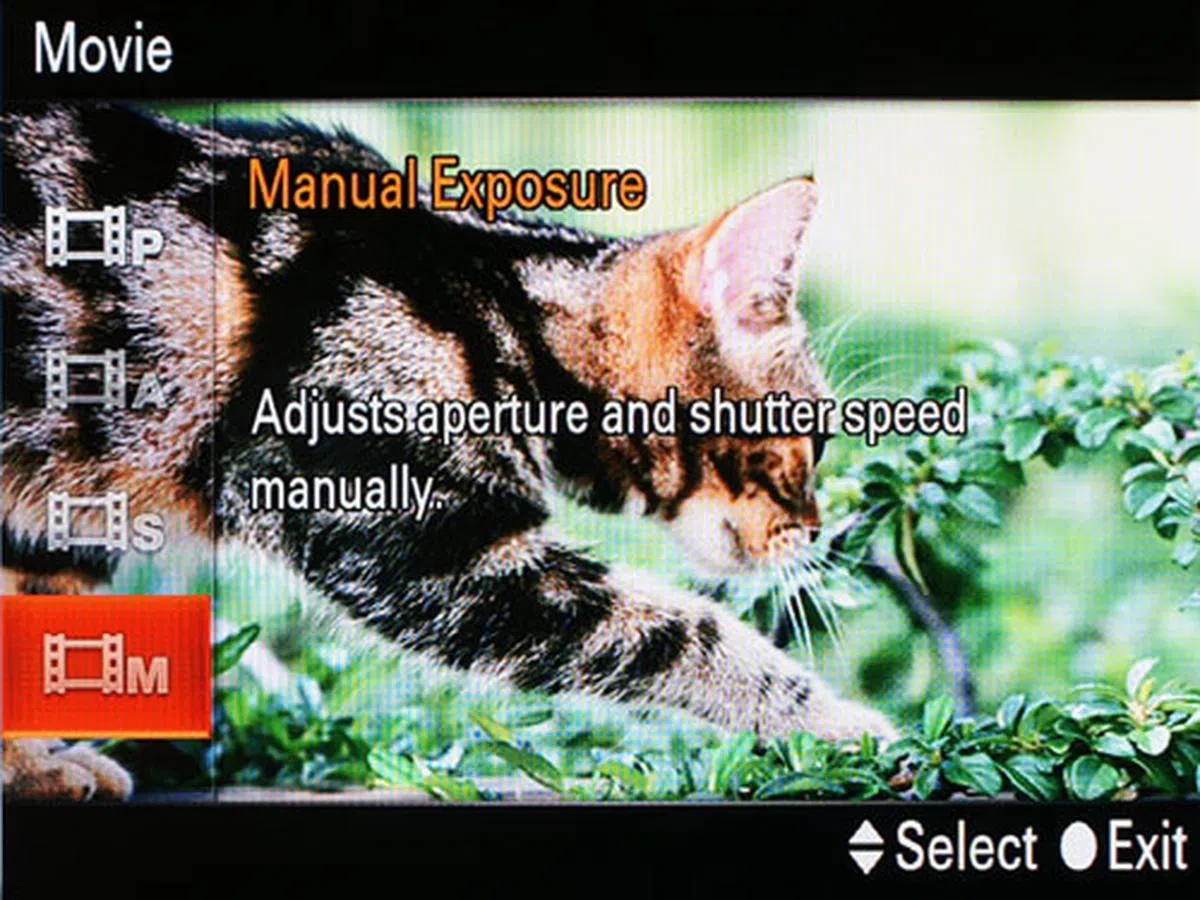 | Any of the P/A/S/M modes can be used for video recording. For aperture-priority, shutter-priority and manual modes, you need to switch to manual focus. During manual focusing, the selected AF point will light up in green to signal that focus is achieved. |
19-point AF System with 11 Cross-type Sensors
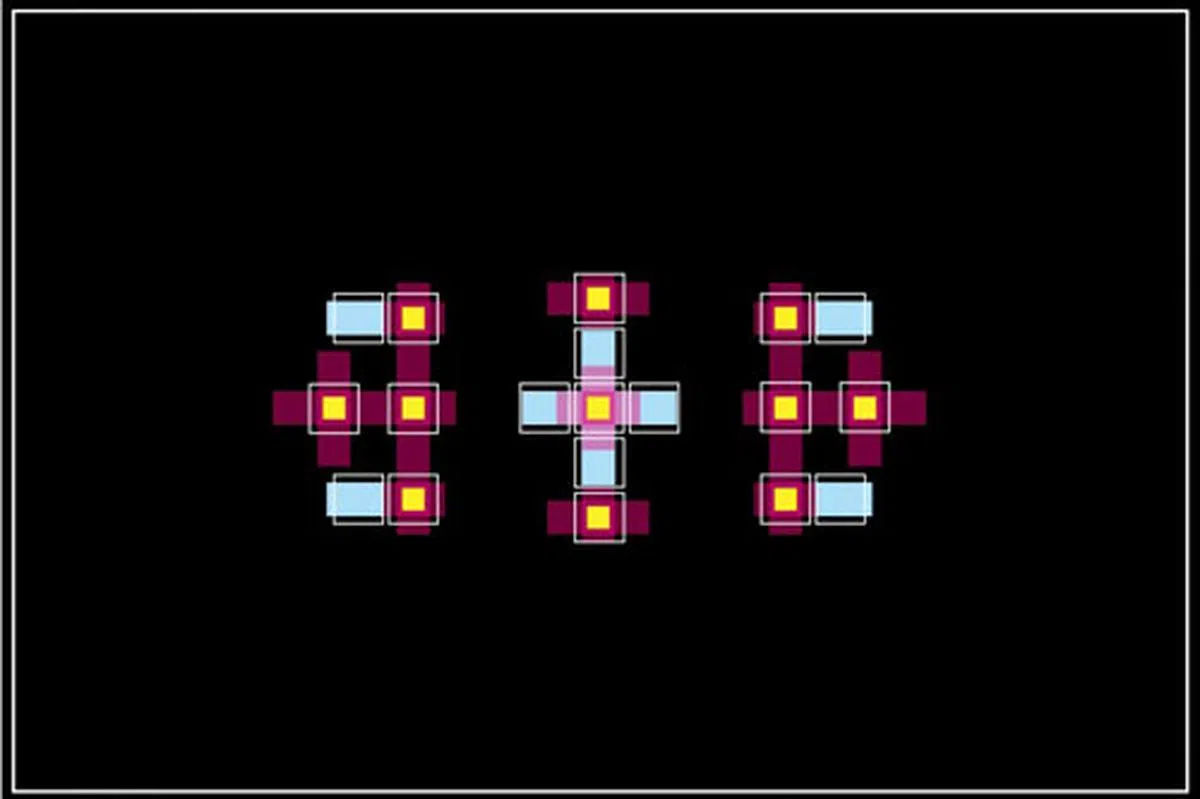 | The SLT-A77 features a new 19-point AF system with 11 cross sensors (shown in purple in the image) and 8 linear ones. Especially under low light conditions, cross sensors are more sensitive and accurate, as they can detect both horizontal and vertical lines. |
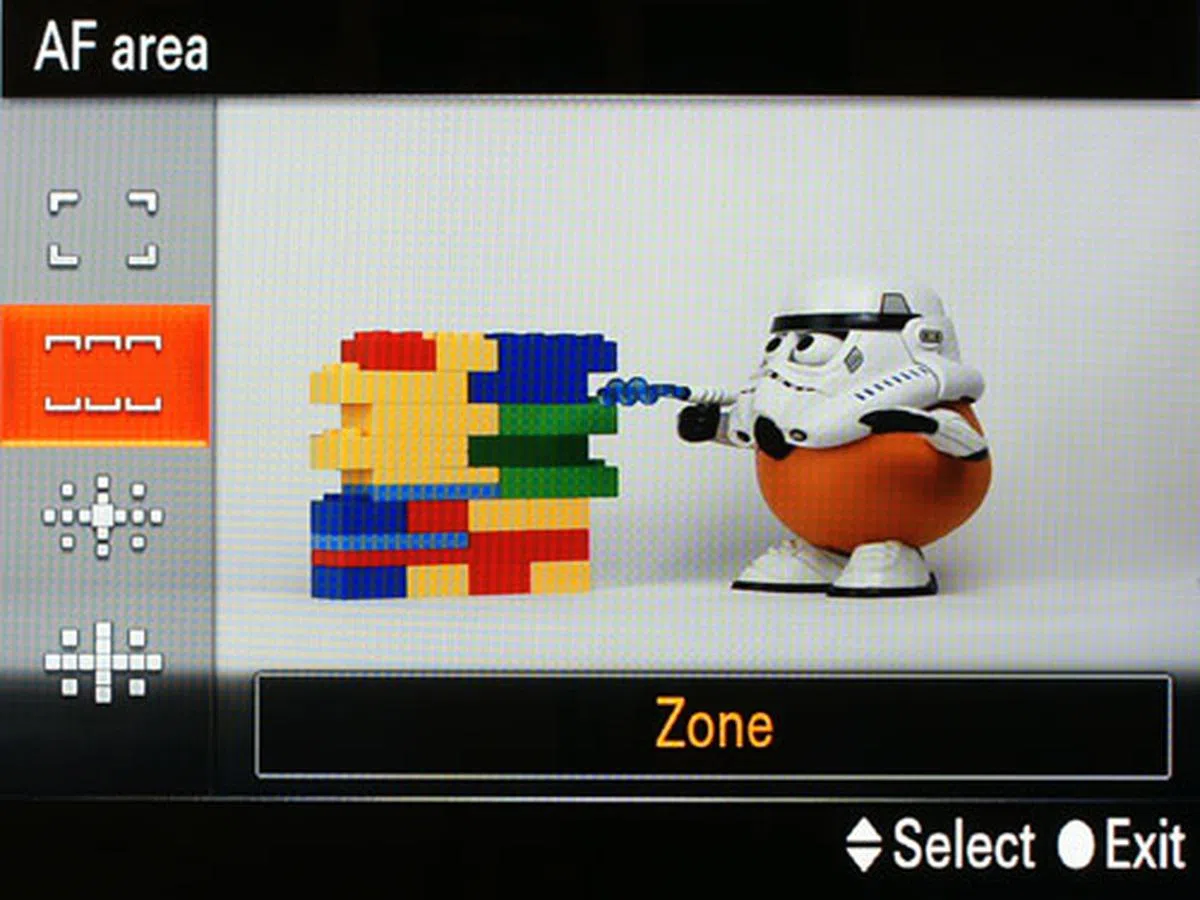 | Four AF area modes are available: Wide (all 19 sensors), Spot (center sensor), Local (user selects any of the 19 sensors) and Zone (left, center or right zone). For Zone AF, only the sensors in the selected zone are used. |
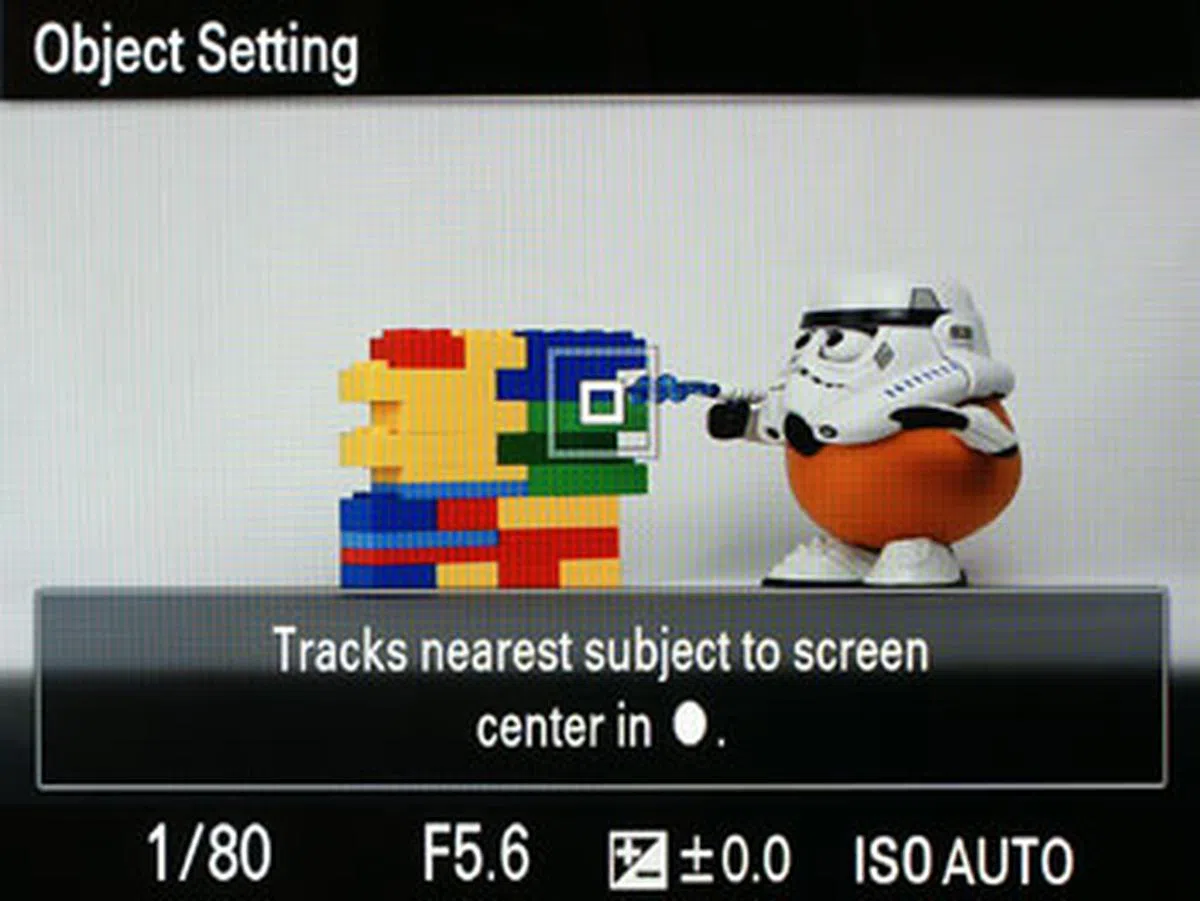 | Tracking Focus allows you to lock on to your subject (press down the joystick, put the subject in the center of the frame, press the joystick again to confirm), track its movement and focus on it continuously across the 19 AF points. |
Top of Camera
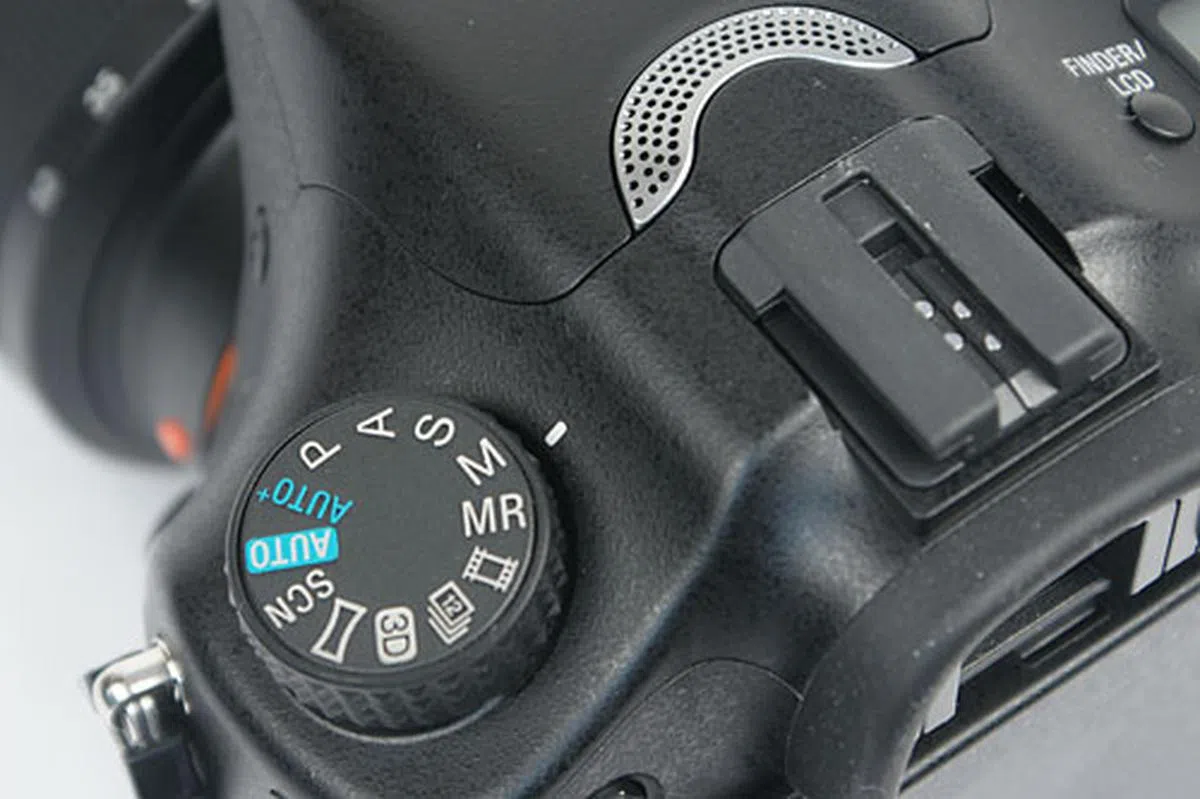 |
On the left of the top plate sits the mode dial. The 12fps burst mode has its own position on the dial, separated from the Drive mode menu. For Auto+ mode, in the menu, you can turn off the option for the camera to automatically switch to continuous shooting, as well as have it save all the images instead of just one. Notice the silver built-in stereo microphone behind the popup flash. Sony says lens drive noise is effectively suppressed by a new noise reduction algorithm. |
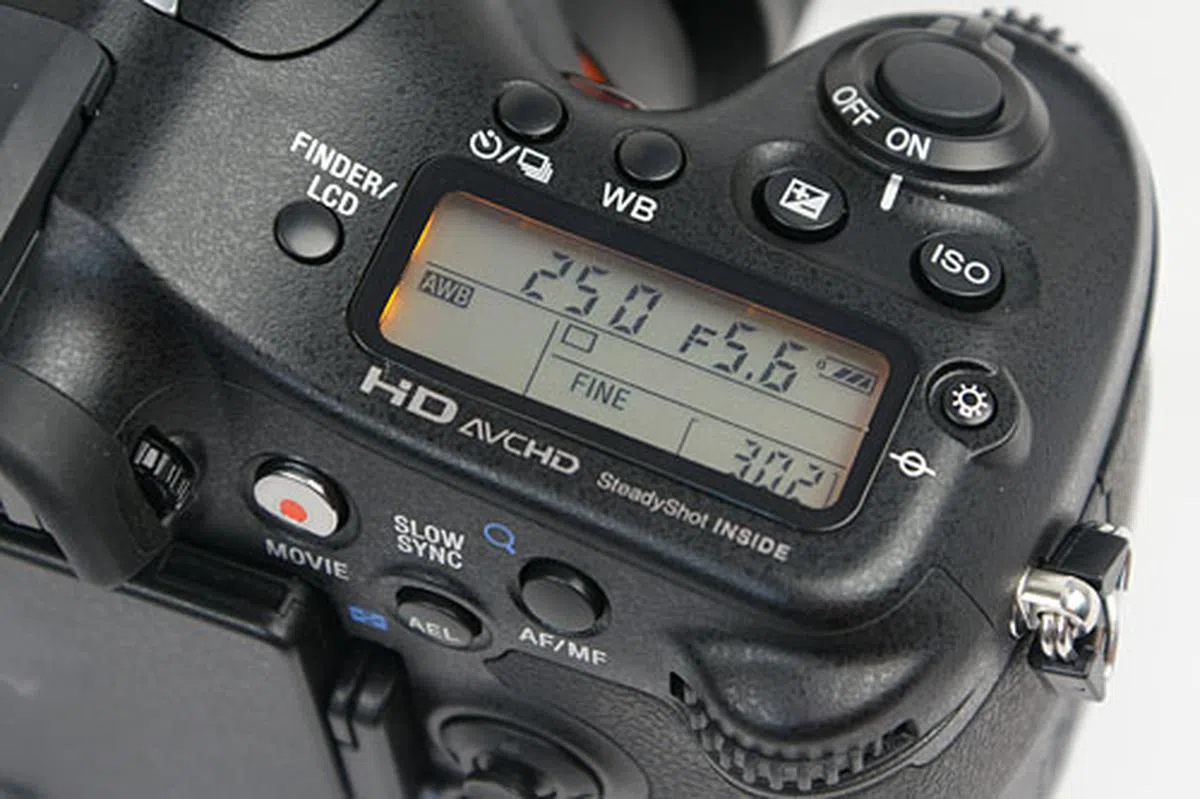 |
Despite the plethora of buttons, the A77 manages to squeeze in a small LCD status panel (with a cinnabar color backlight) at the top of the camera. Most of the key shooting settings such as ISO, white balance, drive mode and AE lock are within reach of either the thumb or index finger. The rear control dial and the AF/MF button (for quickly switching from auto to manual focus) also made a return on this mid-range, enthusiast camera. |
Body Elements
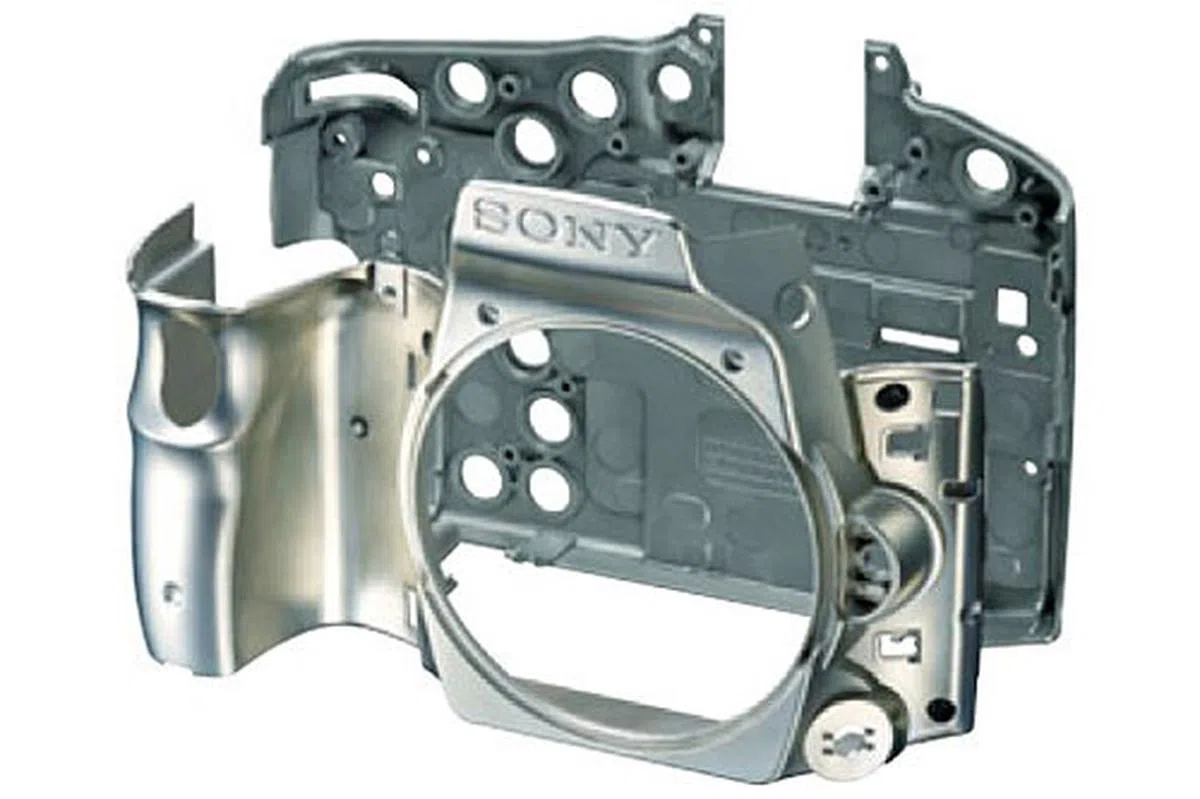 | The front and back of the A77 are made of magnesium alloy. |
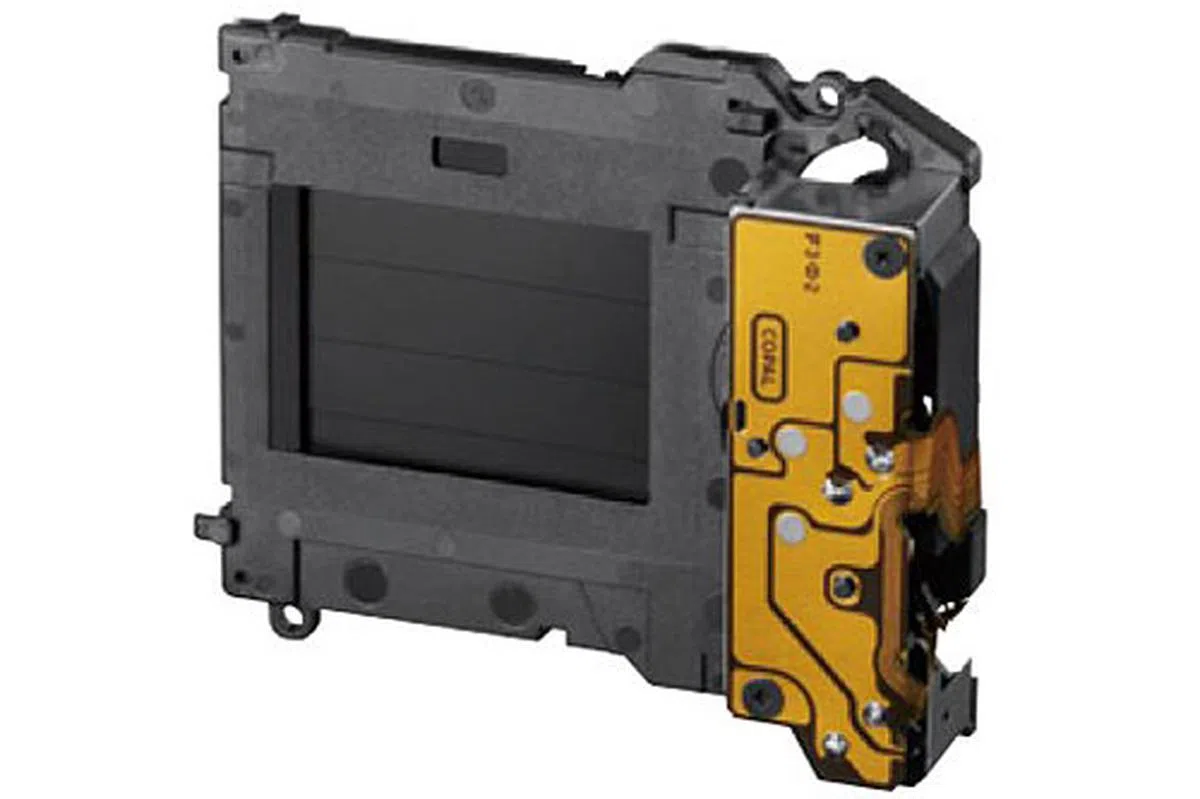 | The shutter is rated at 150,000 releases and offers a top speed of 1/8000 second and a flash sync speed of 1/250 second. By default, the A77 uses an electronic front curtain shutter; Sony claims a release time lag of about 0.05 second, as well as lower shutter noise and vibration. The mechanical front curtain shutter can be activated via the menu. |
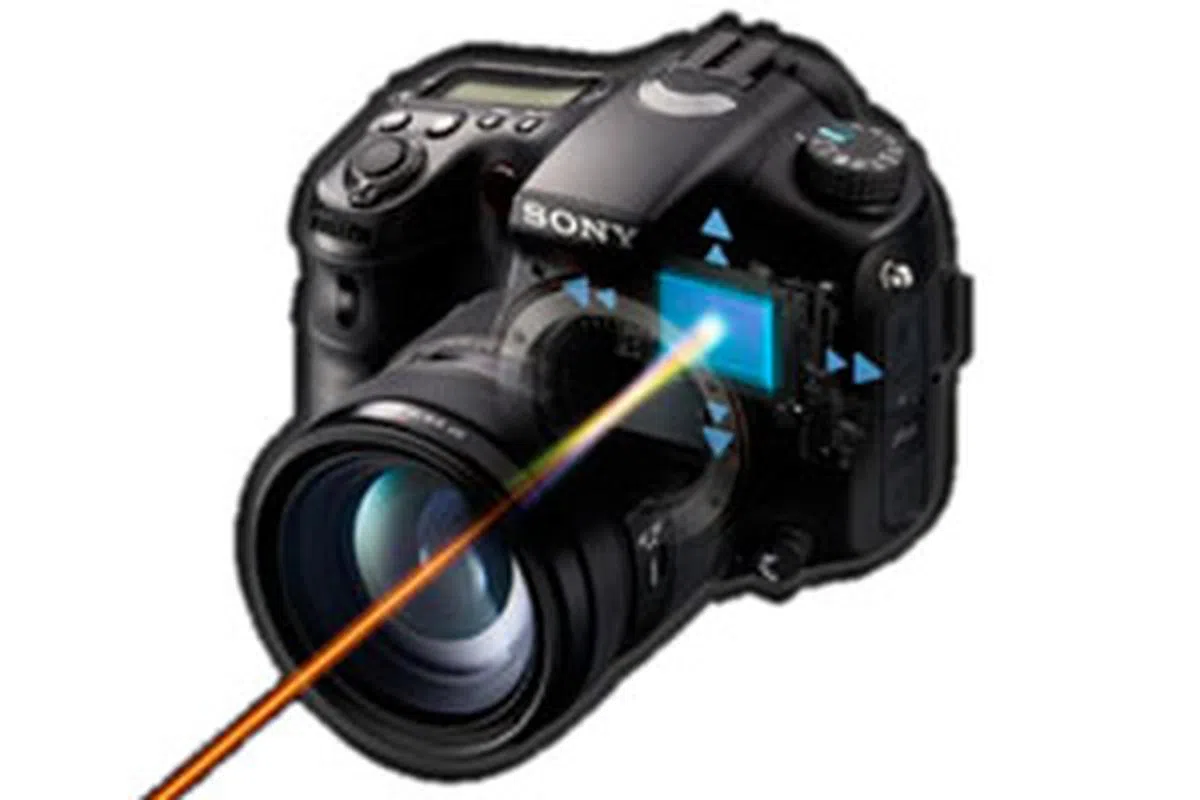 | As usual, the A77 features Sony's sensor-shift, SteadyShot Inside image stabilization system to reduce image blur due to camera shake. Sony claims a 2.5 to 4.5 stop advantage. |
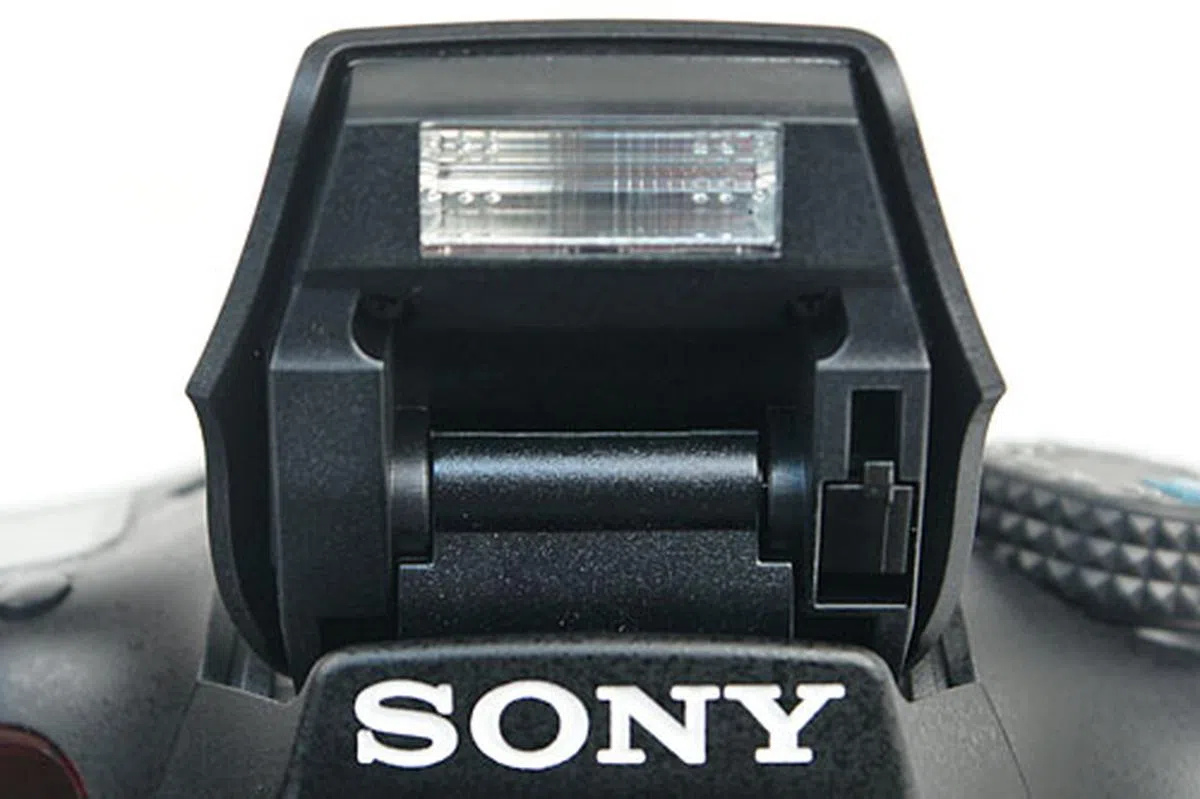 | The A77's built-in flash has a guide number of 12; a manual mode lets you set the intensity from full power to 1/16. In wireless flash mode, it can be used to trigger off-board flash guns. |
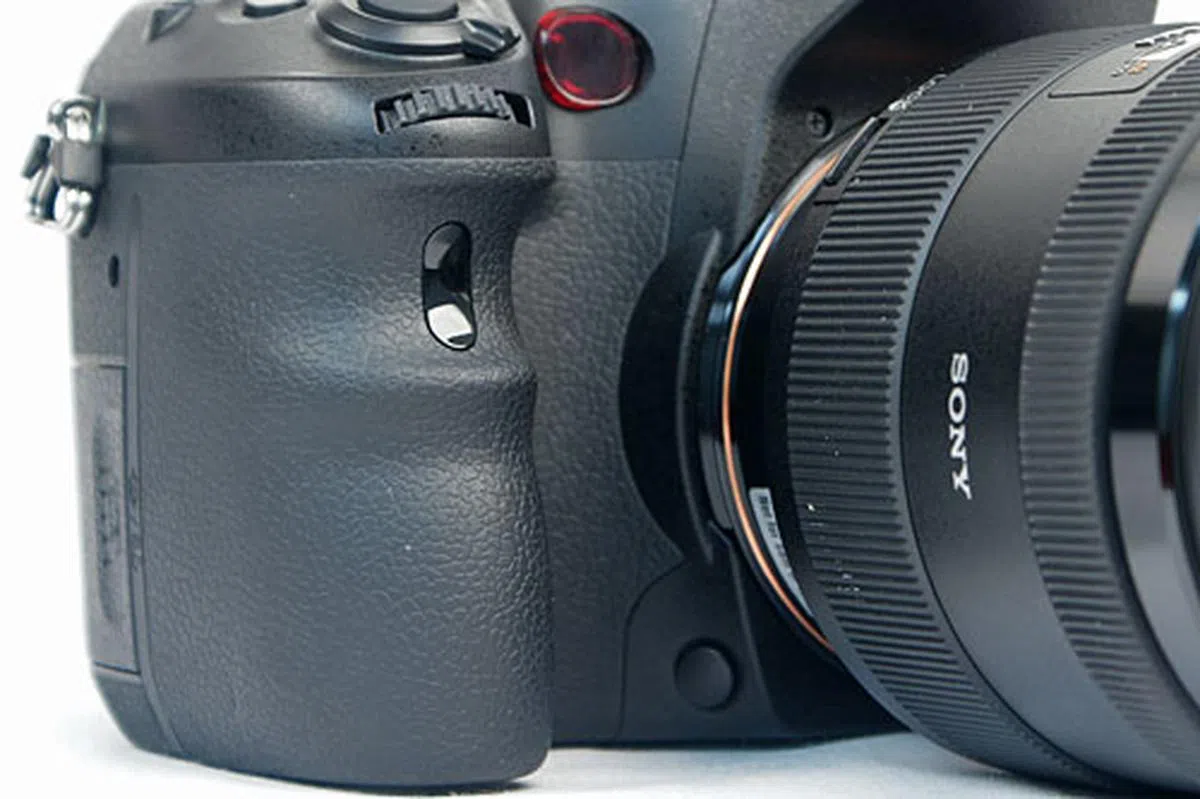 | The A77 has an LED AF illuminator (the one in red) and a remote control sensor on the grip. The aperture preview button near the bottom can be programmed to instead show a preview of the shot. This allows you to additionally see the effects of the selected shutter speed and the Dynamic Range Optimizer setting. |
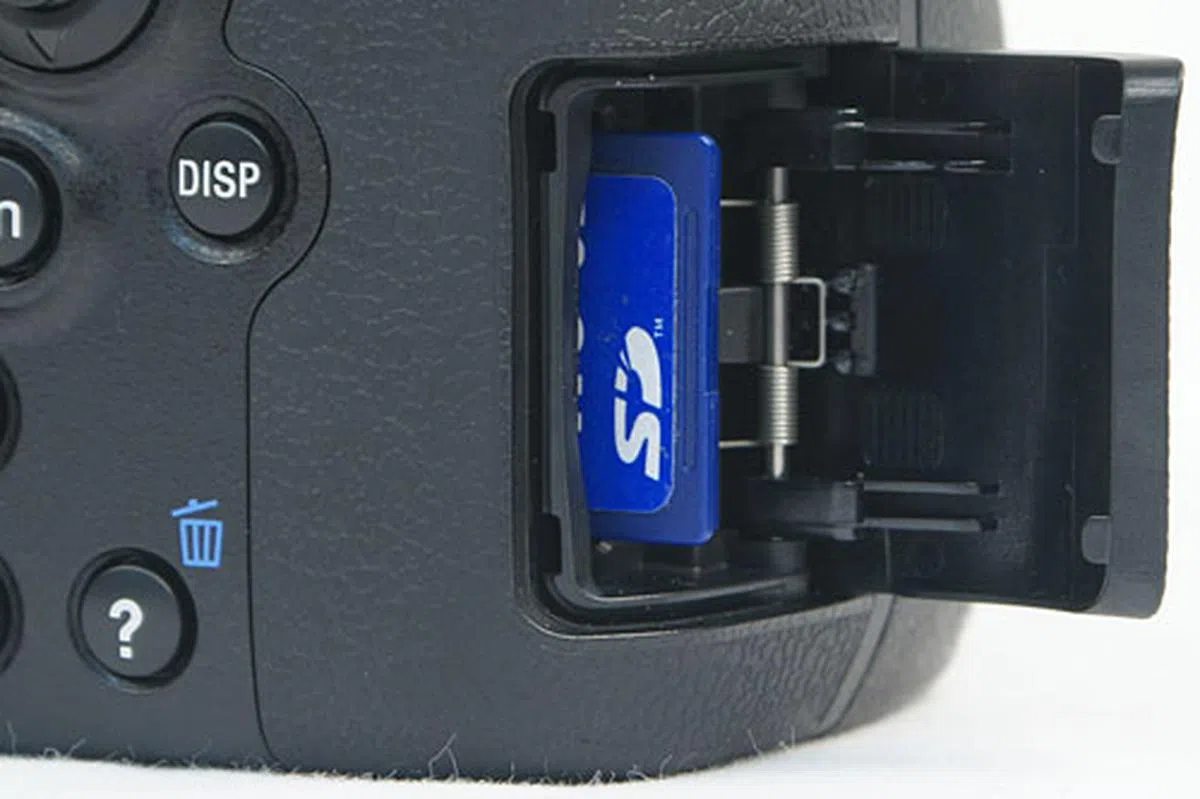 | Unlike the A700/A850/A900, the A77 doesn't accept CompactFlash cards. The single memory slot fits either an SD card or a Memory Stick. We're nitpicking here: The rubber that wraps around the grip and extends to the rear doesn't actually cover the card slot door. Instead, the plastic door has a printed texture. At a glance, you wouldn't notice. |
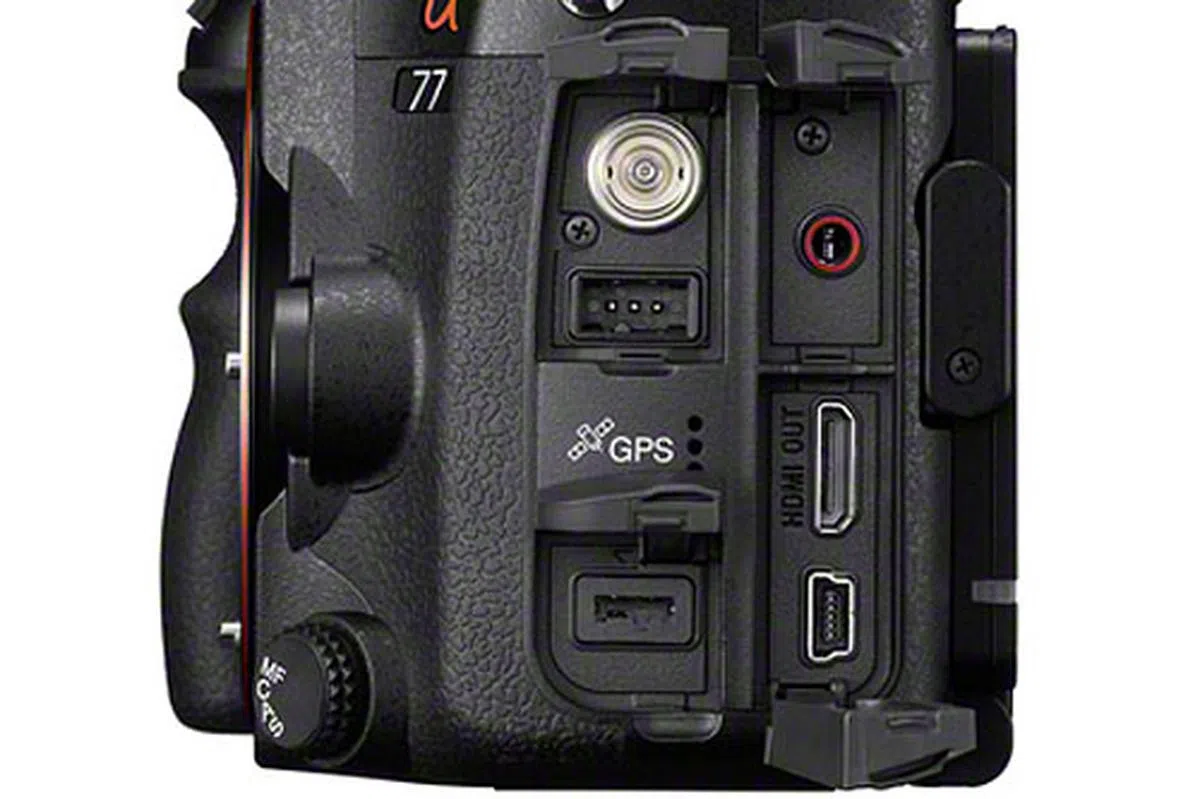 | Under the rubber covers on the left of the A77 are a flash sync terminal, a remote terminal, a DC IN port, a microphone jack, a USB port, and an HDMI terminal. The A77 has a built-in GPS receiver to let you tag photos with location data. You can view the locations on a map by using the bundled PMB software on a PC, or on a Bravia TV that has a Photo Map function. |
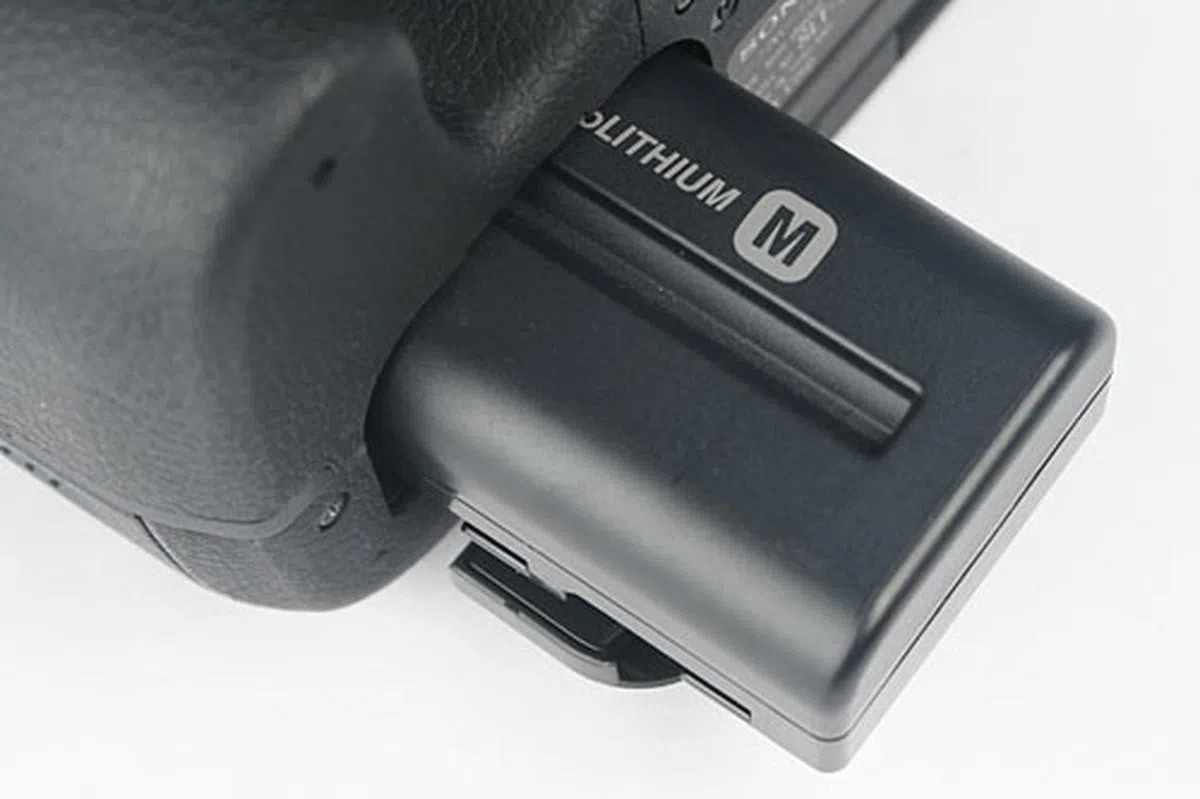 | The A77 has gone back to using the NP-FM500H battery (11.8Wh) that first appeared with the A700. It's rated for about 470 shots with the EVF and 530 shots with the LCD monitor (using the CIPA standard). Movie recording duration is rated at 185 minutes. |
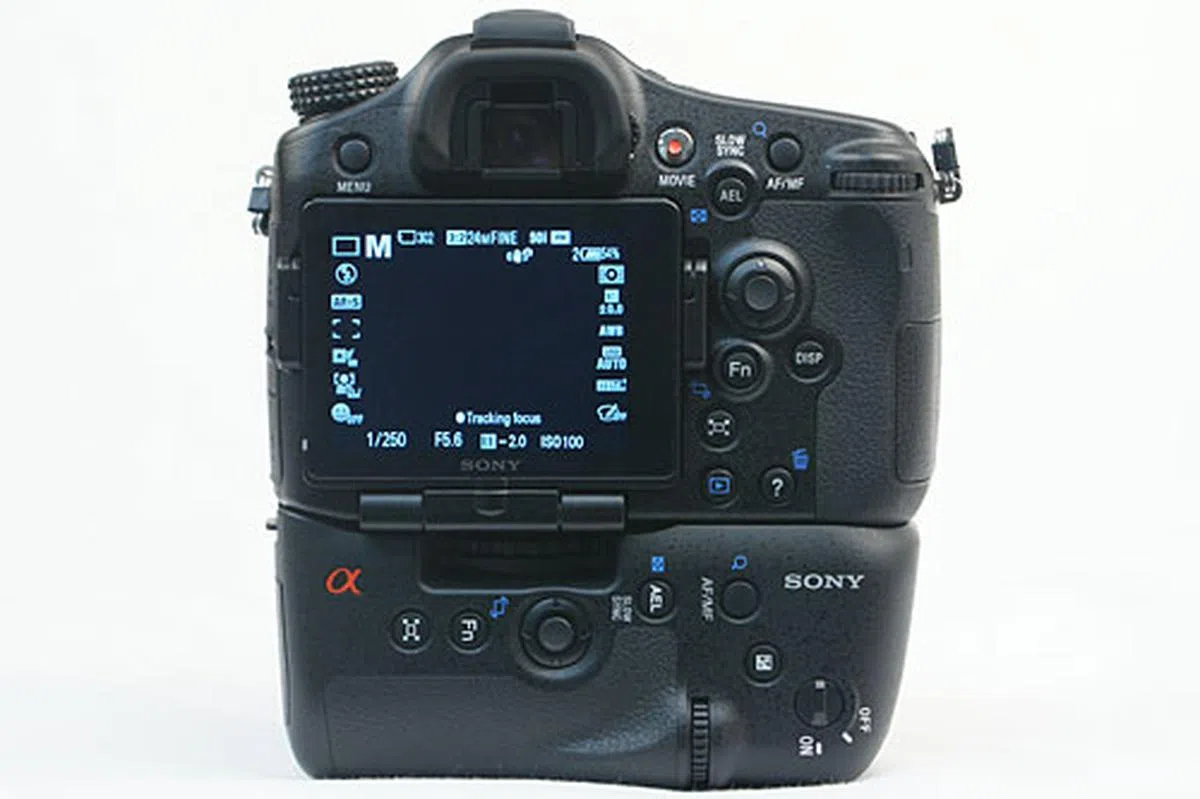 | The optional VG-C77AM vertical grip fits two NP-FM500H batteries, and touts dust and moisture resistance at the same level as the camera body. Sadly, due to the size difference, it can't be used on the A65. |
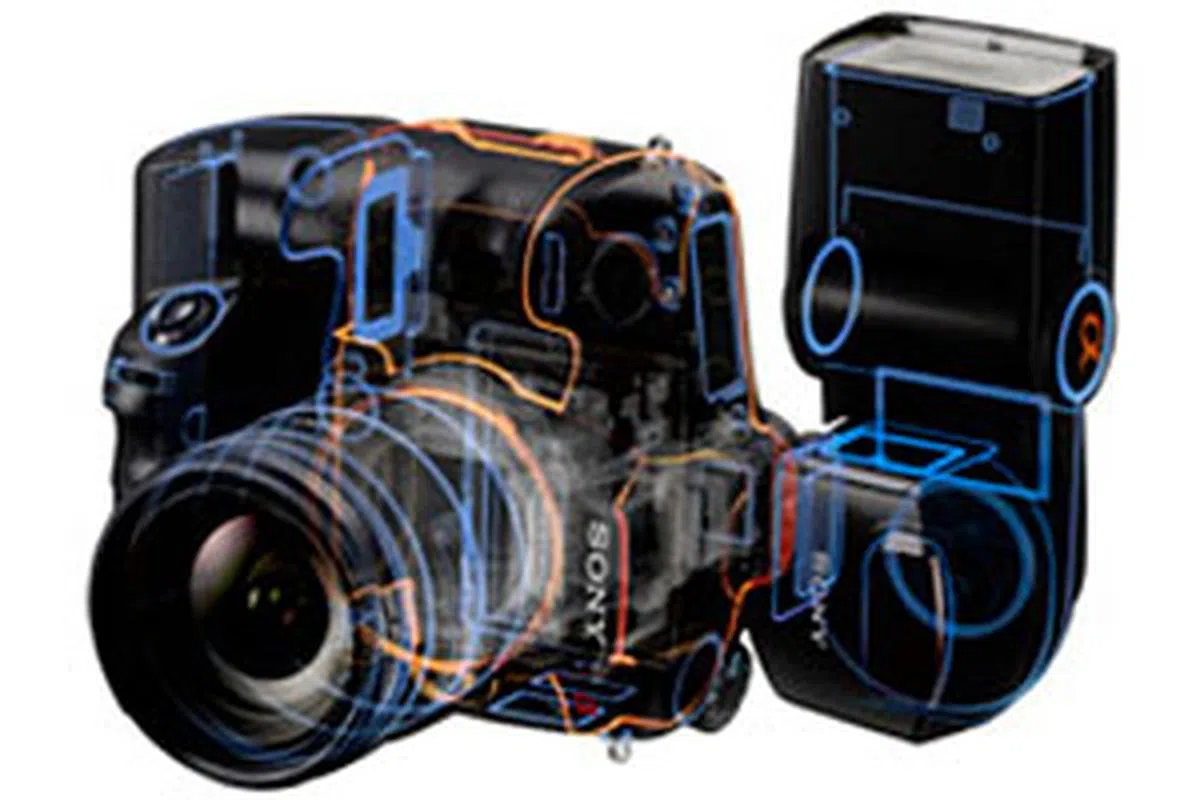 | Buttons and dials on the A77 are sealed to prevent water and dust entry. Measures are also taken to increase the dust and moisture resistance level of the new DT 16-50mm F2.8 SSM lens, VG-C77AM vertical grip and HVL-F43AM (announced in April). That being said, this doesn't mean that they're dust and waterproof. |
Other Noteworthy Features
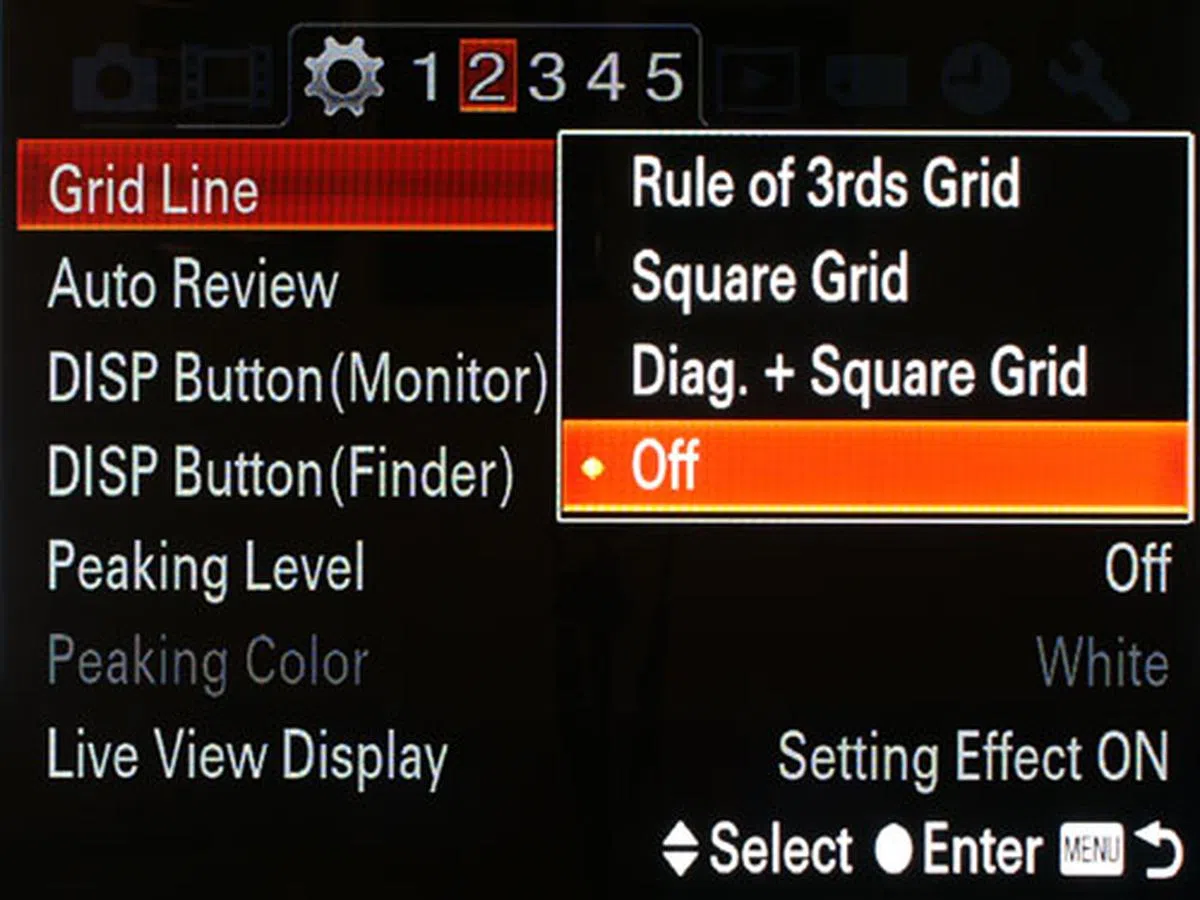 | Need help in your composition? You can choose one of three grid displays to show on the EVF and LCD monitor: a 3-by-3 grid, a 4-by-4 grid (with two 45-degree lines through the center), or a 6-by-4 grid. |
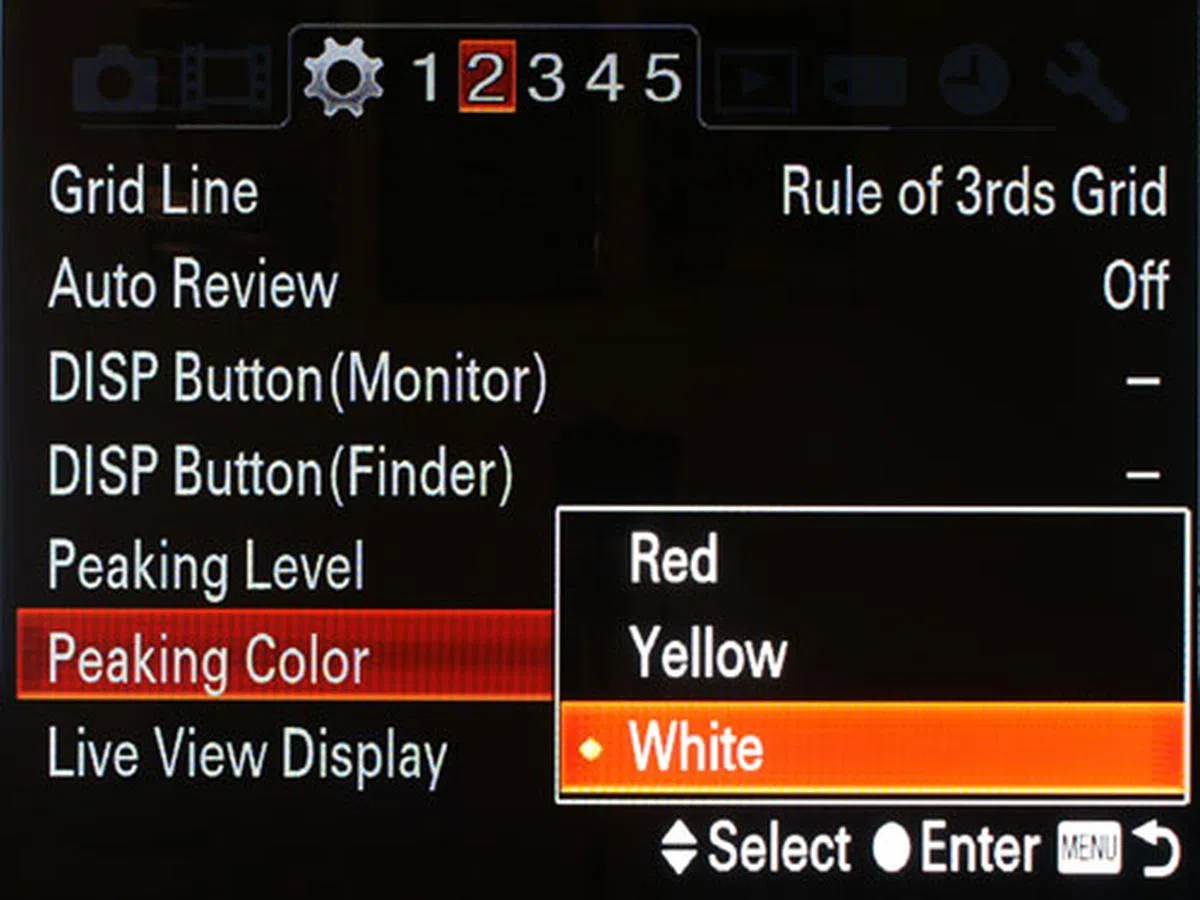 | During manual focusing, you can turn on the Peaking function to help you verify focus; the sharpest, in-focus areas of the image can be highlighted in either red, yellow or white. |
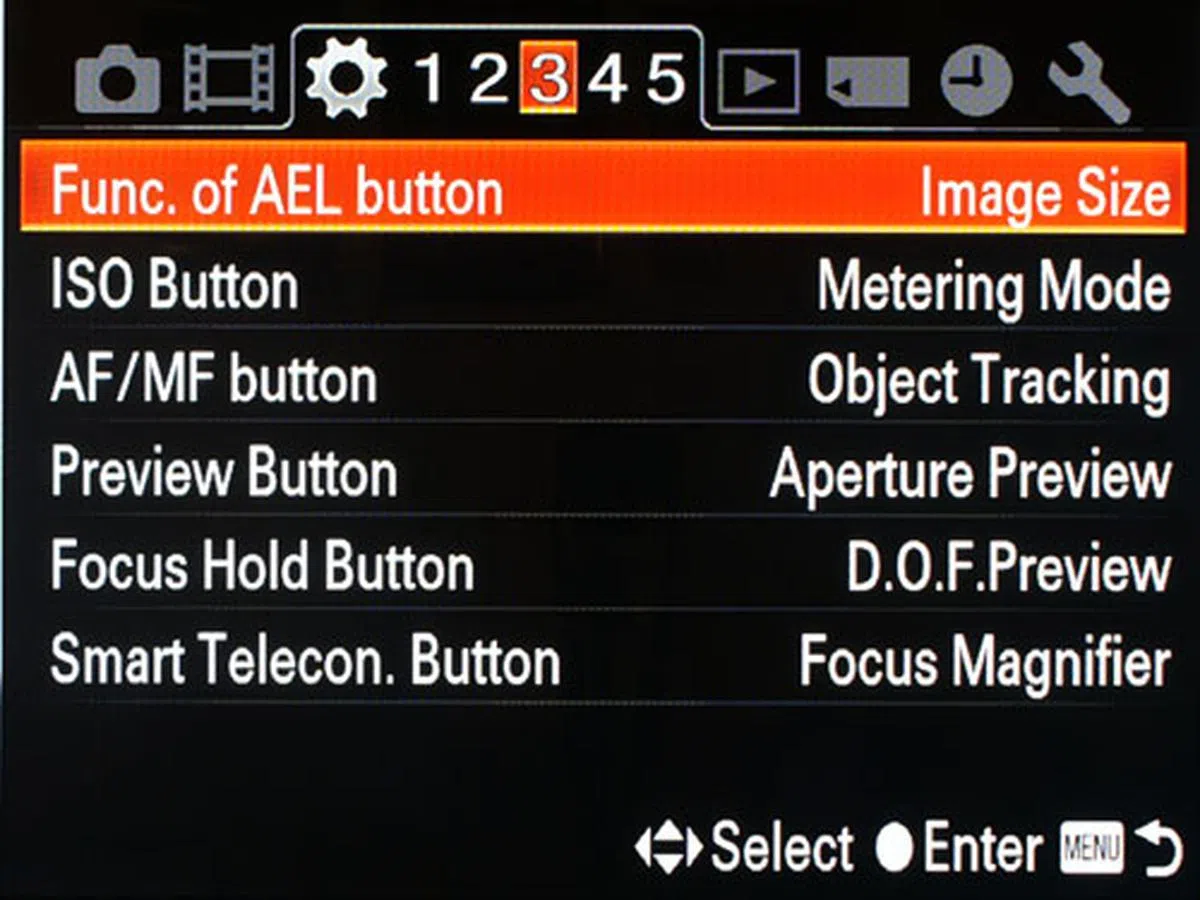 | Many of the buttons on the A77 are customizable. In particular, the AEL, ISO and AF/MF buttons can have their original functions reassigned to any of 24 functions, including drive mode, focus area, metering mode, ISO, Creative Style and DRO/Auto HDR. |
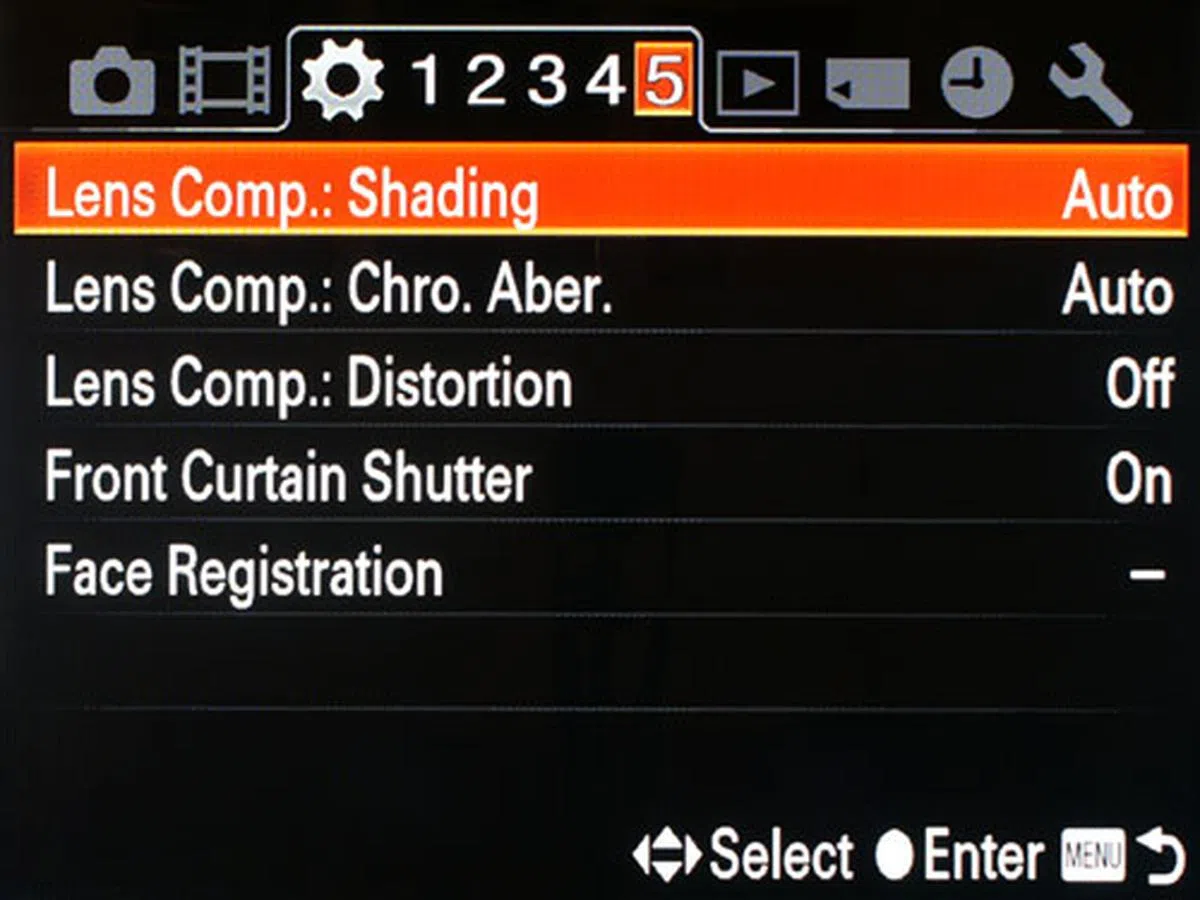 | The A77 is able to perform some in-camera lens corrections, such as correcting edge darkening, color registration errors and distortion. |
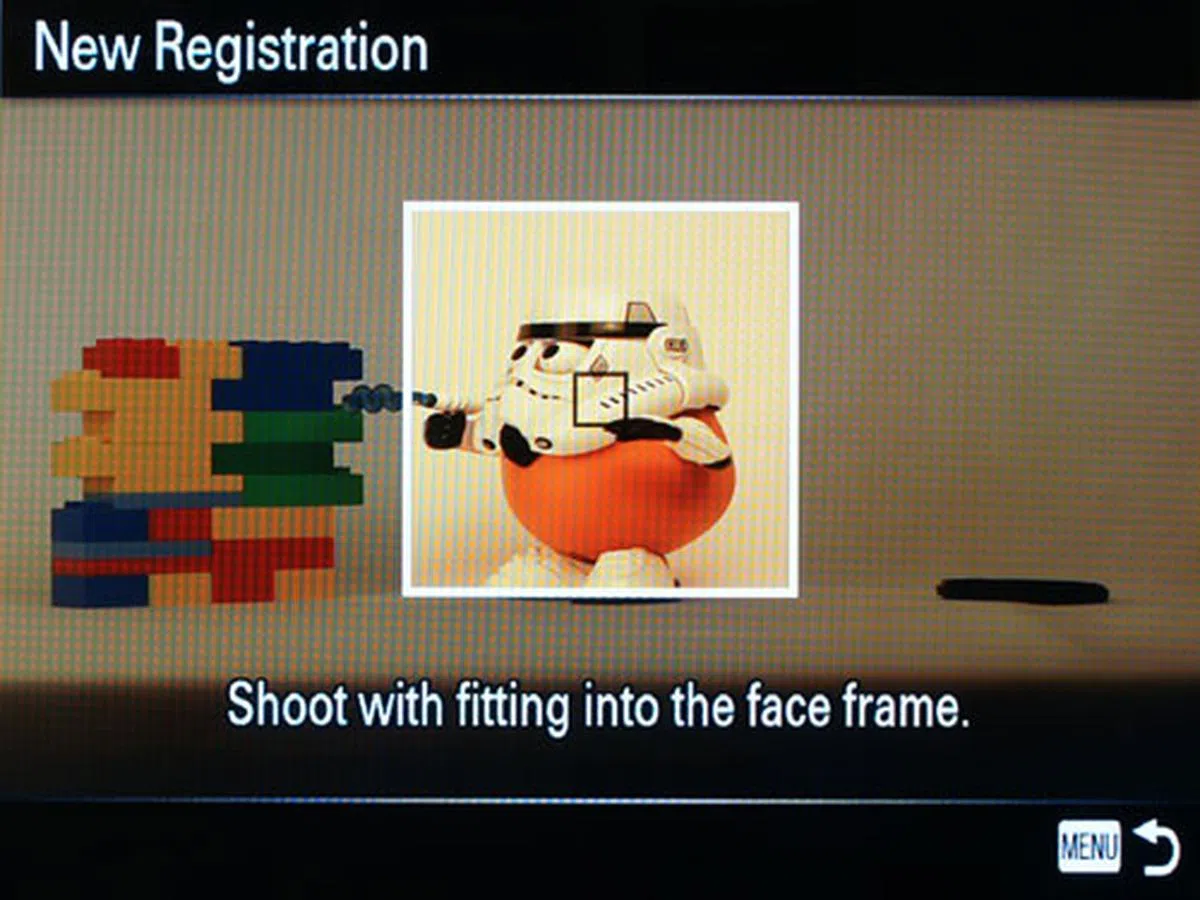 | The A77 features Face Detection that detects up to eight faces, as well as a Smile Shutter function. You can register up to eight faces so that the camera would prioritize them when detecting faces. |
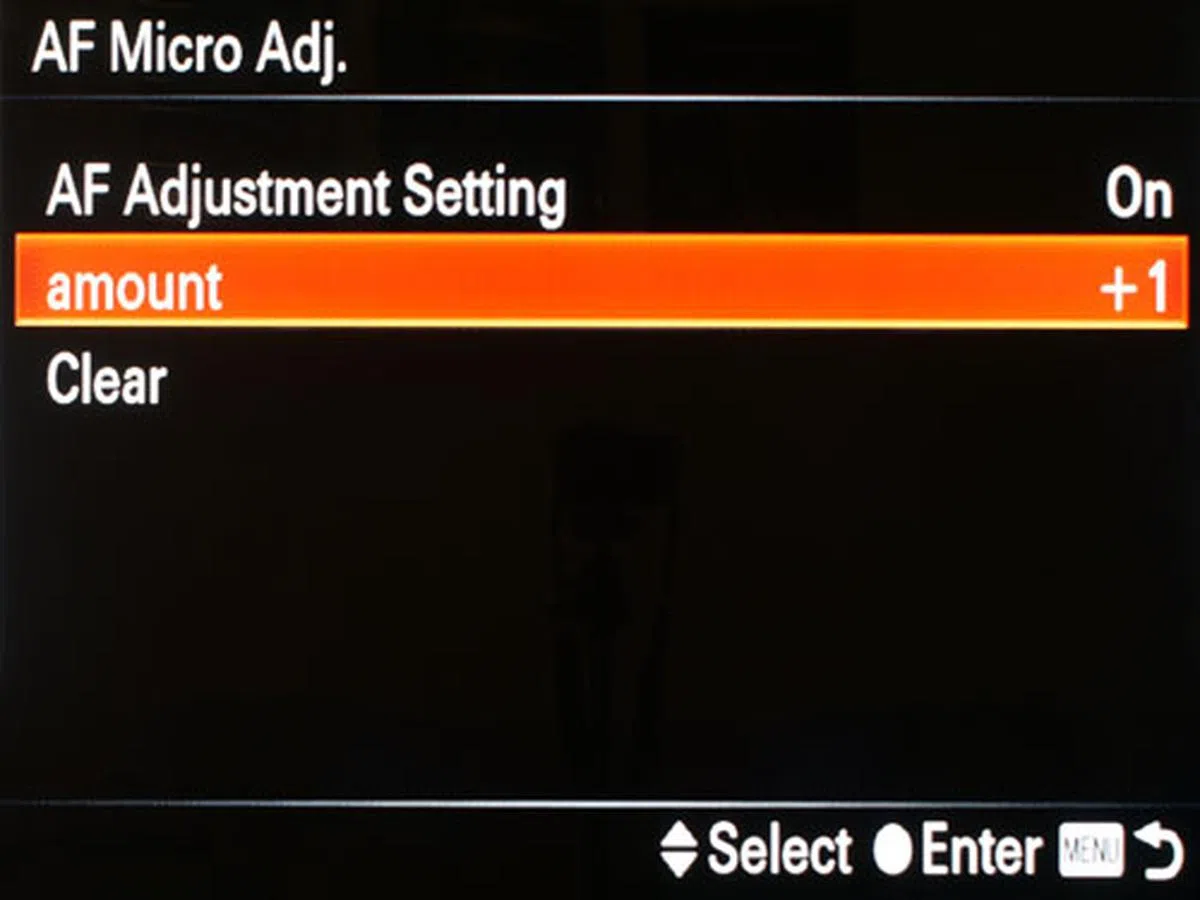 | If you're facing front or rear-focusing issues with your camera and lens combination, there's an AF micro adjustment function for fine-tuning AF accuracy. Up to 30 lens adjustments can be registered. |
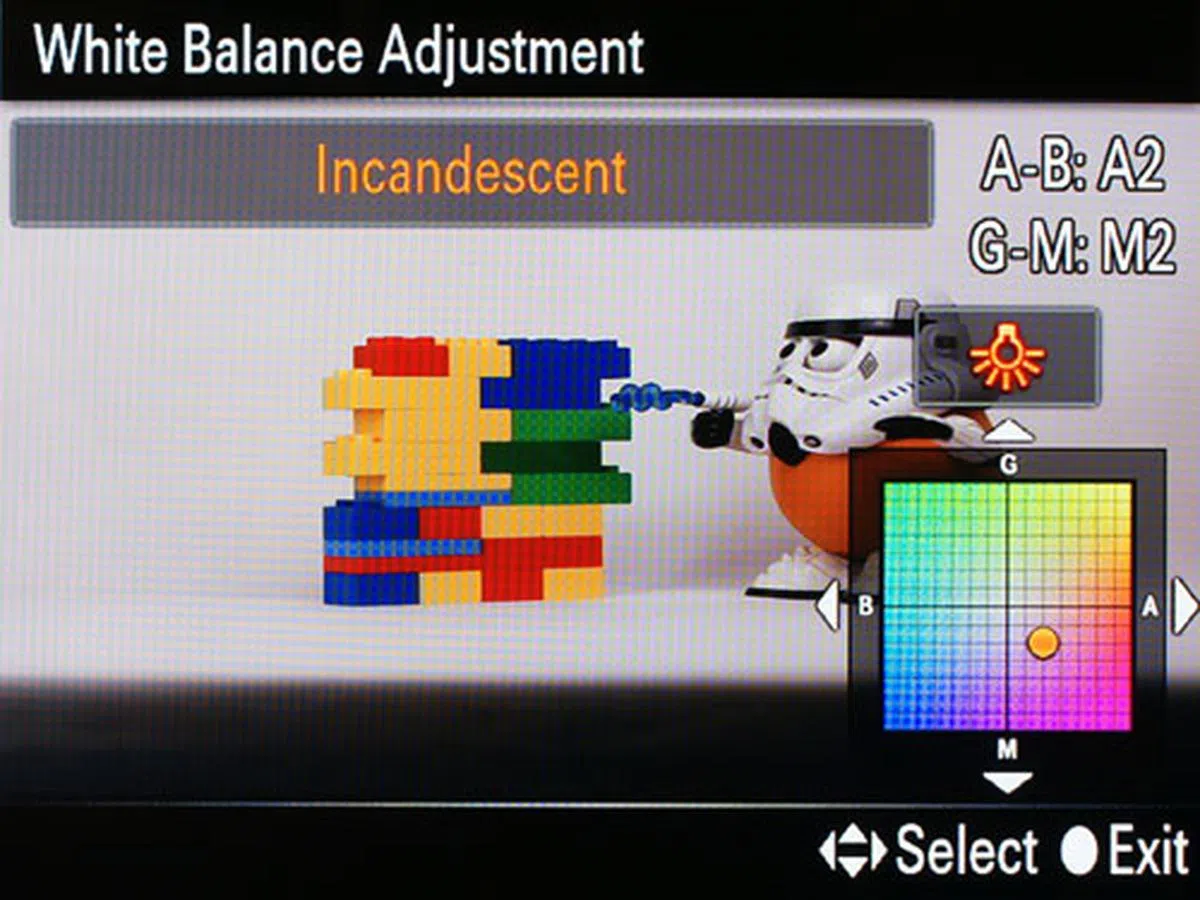 | In addition to white balance presets and Kelvin adjustments, the A77 sports a two-axis white balance mode for finer tweaking: adjustments can be made in the amber-blue and green-magenta directions. |
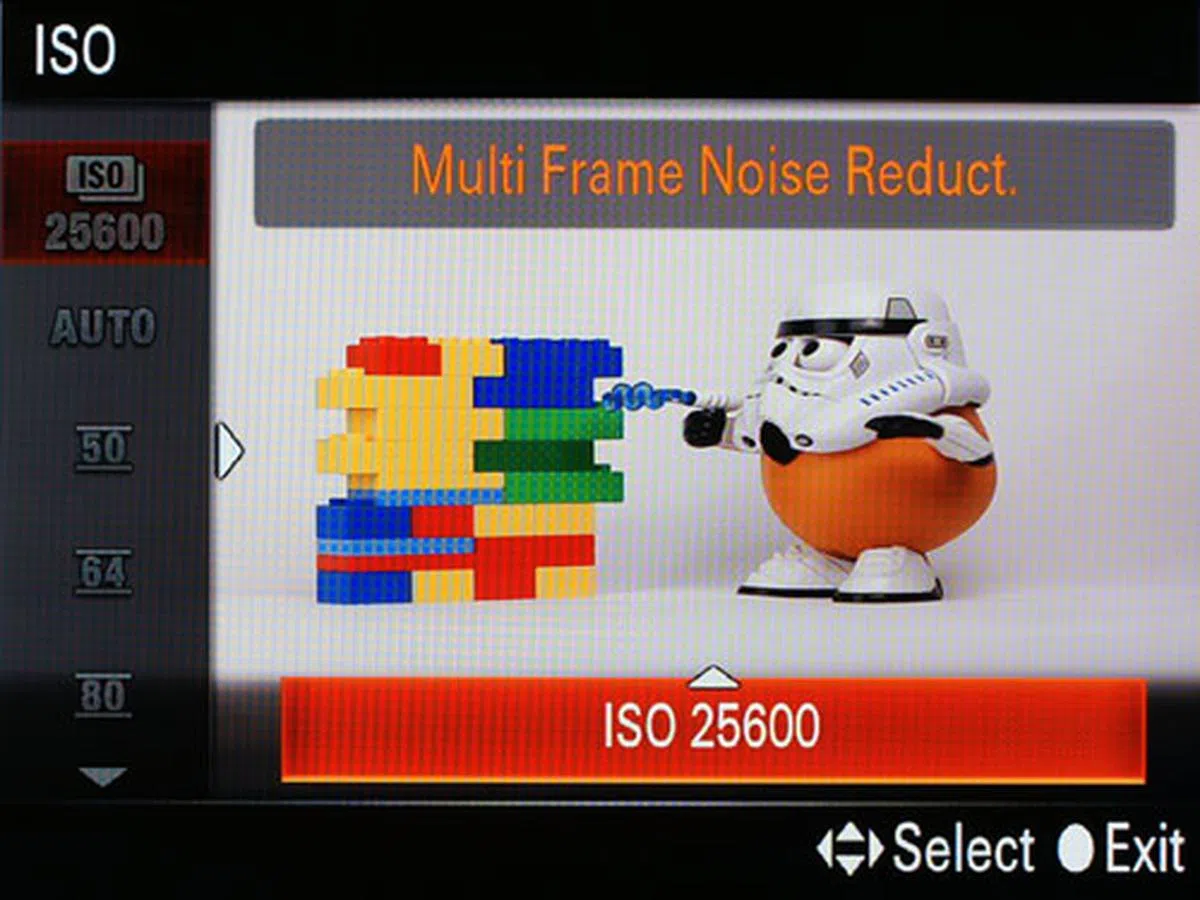 | The Multi Frame Noise Reduction mode captures six frames to create a single image that's sharper and has lower noise. This mode resides in the ISOmenu; you can have the camera choose the ISO, or you can specify it yourself. With this mode, Sony claims that you can achieve a maximum sensitivity equivalent of ISO 25,600. |
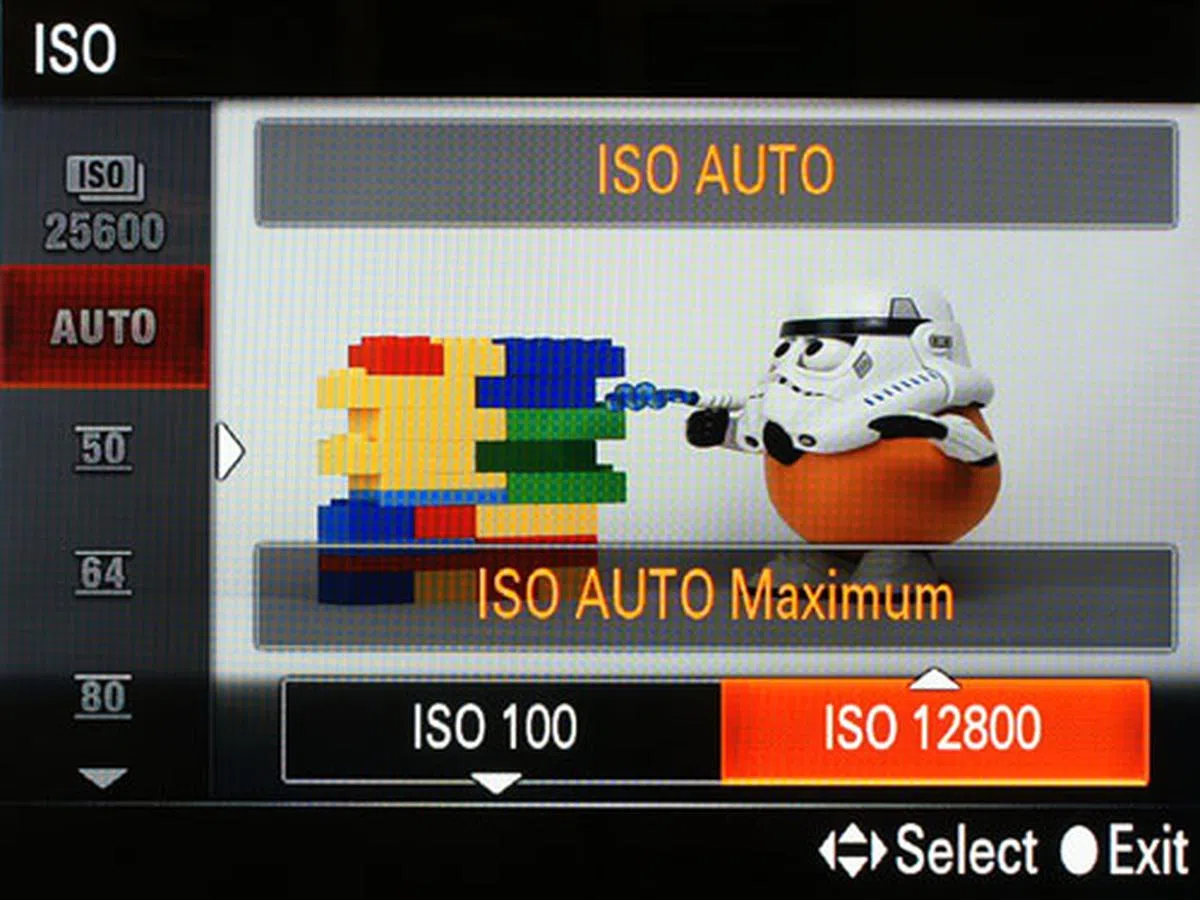 | ISO sensitivity of the A77 ranges from ISO 100 to 16,000. This is expandable down to ISO 50. For ISOAuto mode, the minimum you can set is ISO 100 and the maximum is ISO 12,800. |
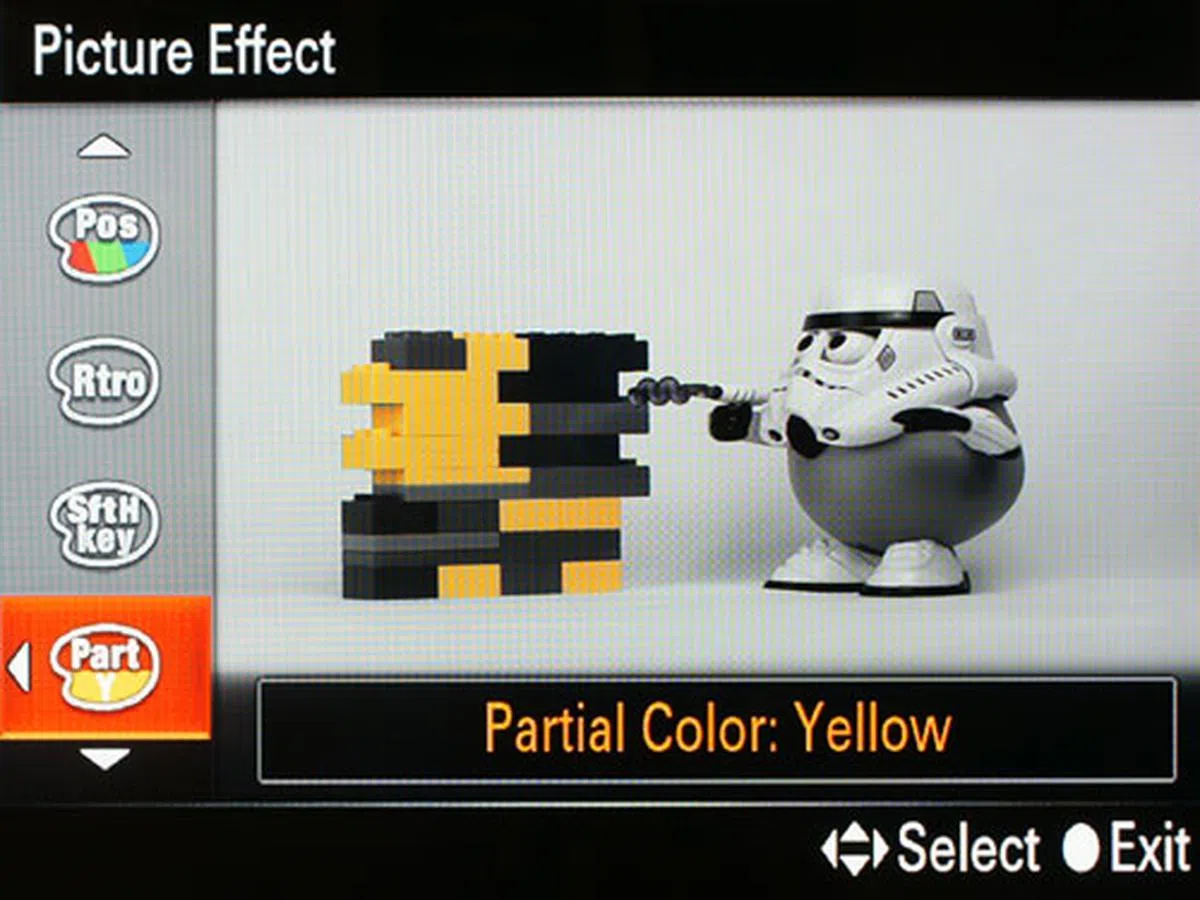 | You can apply effects to your photos and videos. There are 11 modes (with 15 effects) to choose from. New effects include HDR Painting, Rich Tone Monochrome, Soft Focus and Miniature. |
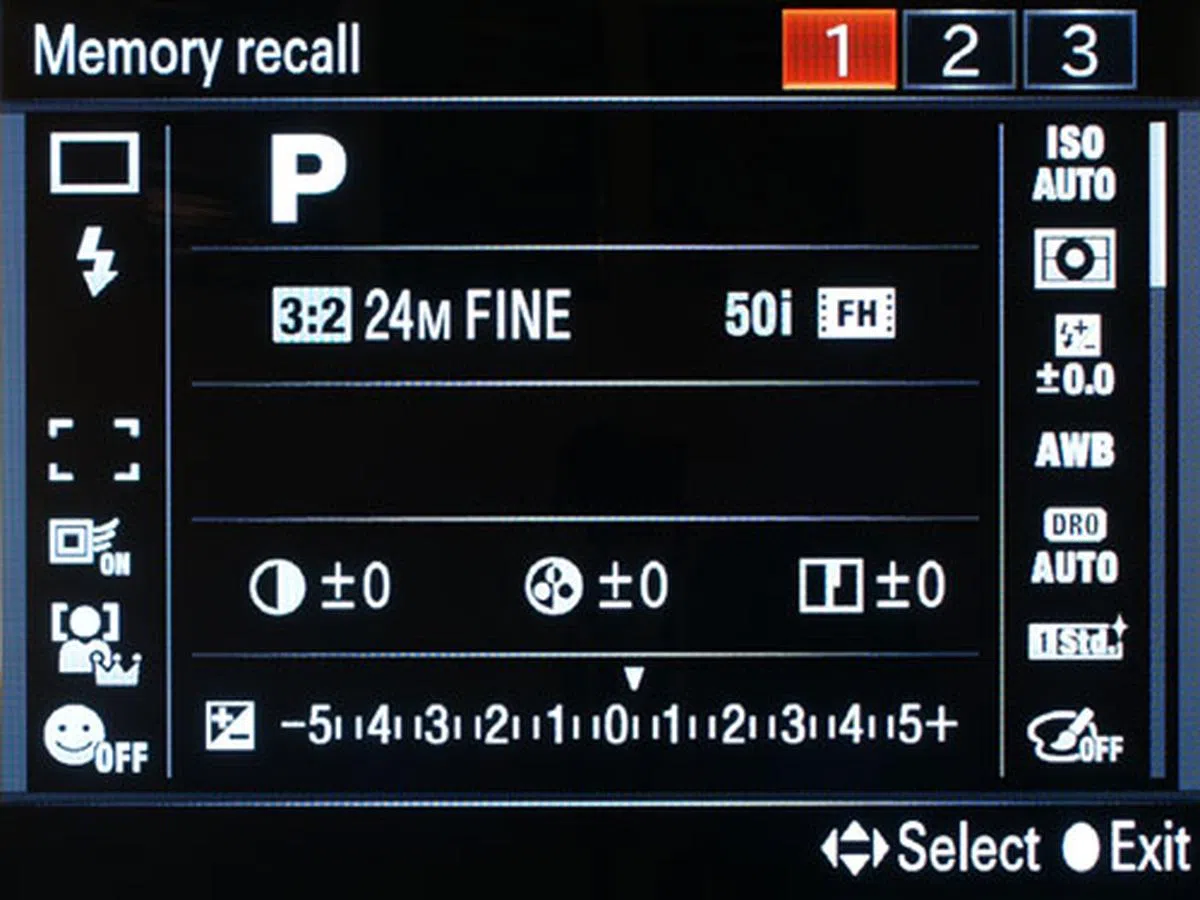 | You can use the Memory Recall function to save up to three sets of camera settings for future recall. To get to the saved settings, just turn the mode dial at the top of the camera to the position marked 'MR', then use the joystick to navigate and pick the set to use. |
Our articles may contain affiliate links. If you buy through these links, we may earn a small commission.
